Delve into the exquisite world of Japanese desserts and sweets, where each bite is a delicate balance of flavors, textures, and artistic presentation. Japanese confections, known as wagashi, reflect the nation's rich cultural heritage and reverence for seasonal ingredients. From delicate mochi filled with sweet red bean paste to intricate yokan jelly, these treats embody a centuries-old tradition of craftsmanship and attention to detail. Meanwhile, modern Japanese desserts like fluffy soufflé pancakes and creamy matcha tiramisu showcase innovative flavors and techniques. Whether enjoyed with a cup of green tea or as a sweet ending to a meal, Japanese desserts offer a sublime culinary experience
Raindrop Cake
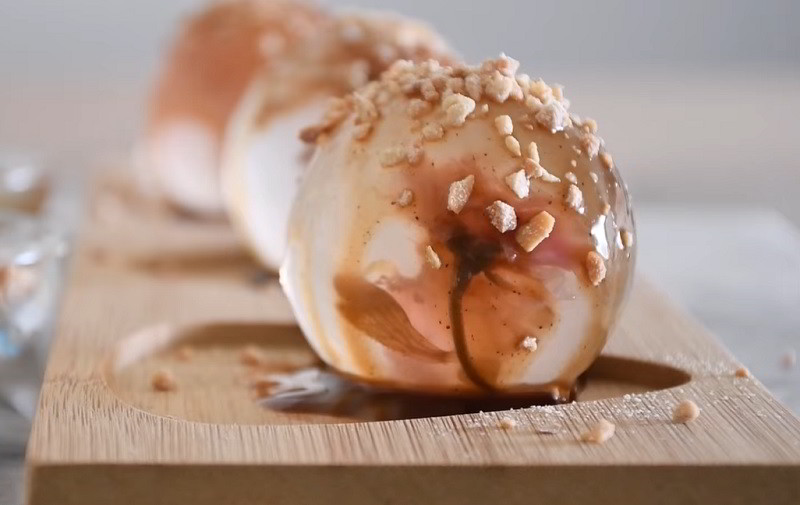
The Japanese cuisine is renowned for its unique and exquisite desserts, and one such intriguing delicacy is the Raindrop Cake. Also known as Mizu Shingen Mochi, this dessert is a transparent, jelly-like creation that resembles a droplet of water. It is made from mineral water and agar-agar, a type of gelatin derived from seaweed. The Raindrop Cake is often served with kinako, a roasted soybean flour, and sweet molasses syrup known as kuromitsu. These accompaniments enhance the delicate and subtle taste of the cake, adding a nutty and sweet flavor to the overall experience. The texture of the Raindrop Cake is truly remarkable. It is incredibly soft and smooth, almost like a gentle raindrop dissolving on your tongue. Its simplicity and purity make it a visually stunning dessert that is as much a feast for the eyes as it is for the palate. This unique Japanese sweet is not only delicious but also a work of art, showcasing the country's emphasis on aesthetics and culinary craftsmanship. The Raindrop Cake is a must-try for anyone seeking a truly ethereal dessert experience.
Mochi
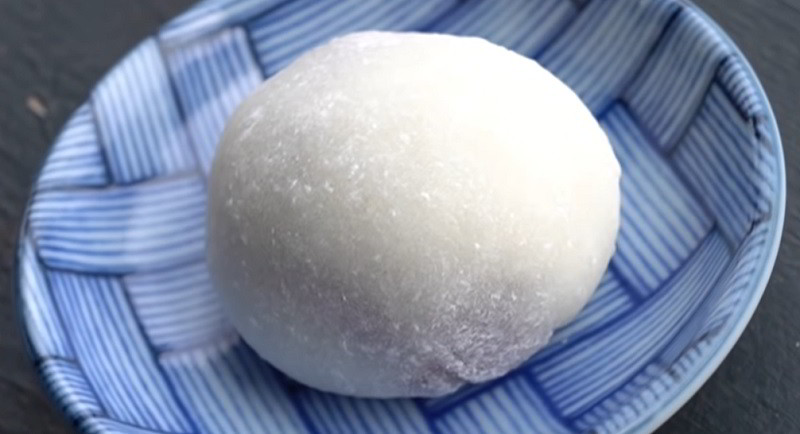
Mochi is a traditional Japanese dessert that is loved by many. It is a sweet and chewy rice cake made from mochigome—a short grain glutinous rice, sugar, water, and cornstarch. To make mochi, steamed rice is pounded into paste and molded into the desired shape. Mochi can come in various shapes and sizes, but it is typically formed into small, round dumplings. These dumplings are often filled with different types of sweet fillings, such as red bean paste, matcha (green tea) cream, or fruit preserves. Mochi is commonly enjoyed during special occasions and festivals in Japan, as well as year-round. It is often served as a part of tea ceremonies or as a sweet treat after a meal. The texture of mochi is soft and chewy, and it has a subtle sweetness that is not overpowering. In addition to being a delightful dessert on its own, mochi is also used in other Japanese dishes and sweets. It can be incorporated into ice cream, used as a topping for shaved ice, or even grilled and served with soy sauce for a savory twist.
Purin
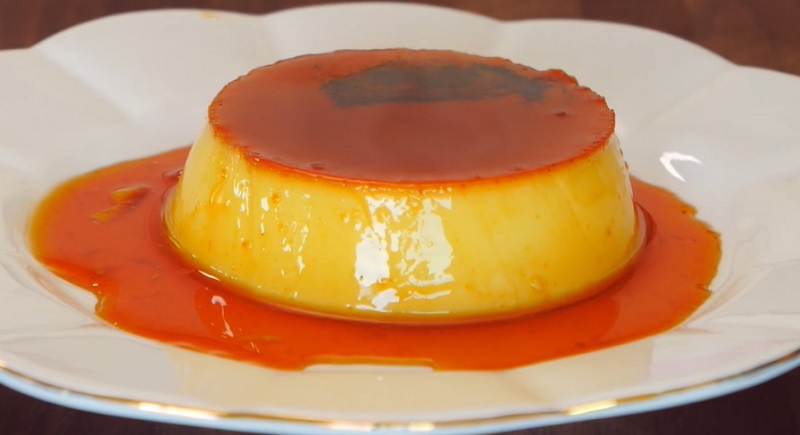
Purin is a custard-based dessert that is often served chilled. To make purin, a caramel sauce is first prepared by melting sugar until it turns golden brown and then pouring it into ramekins or molds. The custard mixture, made from eggs, milk, sugar, and vanilla, is then poured over the caramel and baked in a water bath until set. Once cooled, the dessert is refrigerated to allow the flavors to meld together and the caramel to solidify. The result is a smooth and creamy custard with a layer of amber-colored caramel on top. When served, the purin is inverted onto a plate, allowing the caramel to drip down the sides and create a beautiful presentation. The custard is delicately sweet with a hint of vanilla, and the caramel adds a slightly bitter and sweet contrast.
Dango
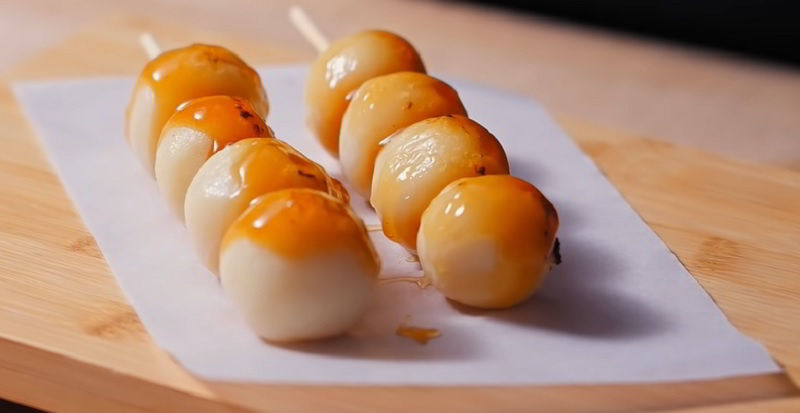
Dango is a traditional Japanese dessert that consists of small, round dumplings made from mochiko (glutinous rice flour). It is a popular dish enjoyed during festivals and special occasions. Dango is typically skewered onto bamboo sticks and served in groups of three or four. There are several variations of dango, each with its own unique flavor and presentation. The most common types include mitarashi dango, which is coated in a sweet soy glaze, and anko dango, which has a filling of sweet red bean paste. Other variations include yomogi dango, which is infused with mugwort and has a distinctive green color, and kushi dango, which is served with a variety of toppings like kinako (roasted soybean flour) or sesame seeds. The texture of dango is soft and chewy, with a slightly sticky consistency. It has a delicate sweetness that is not overpowering, making it a delightful treat for those with a sweet tooth. The combination of the soft dumplings and the sweet glaze or filling creates a harmonious balance of flavors.
Taiyaki
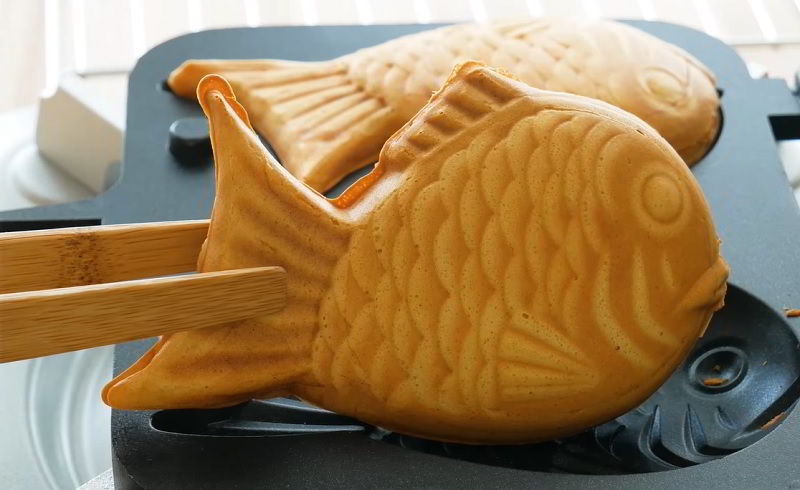
Taiyaki is a delicious treat made from a pancake-like batter that is cooked in a fish-shaped mold. The result is a crispy on the outside, soft and fluffy on the inside pastry that is filled with various sweet fillings. Traditionally, the most common filling for taiyaki is sweet red bean paste, known as anko. This smooth and slightly sweet paste complements the crispy texture of the pastry perfectly. However, nowadays, you can find taiyaki with a wide range of fillings, such as custard, chocolate, matcha, and even savory options like cheese or sausage. The name "taiyaki" itself translates to "baked sea bream," which is a fish commonly associated with good luck in Japanese culture. This adds to the charm of the dish, making it not only delicious but also a symbol of good fortune.
Castella
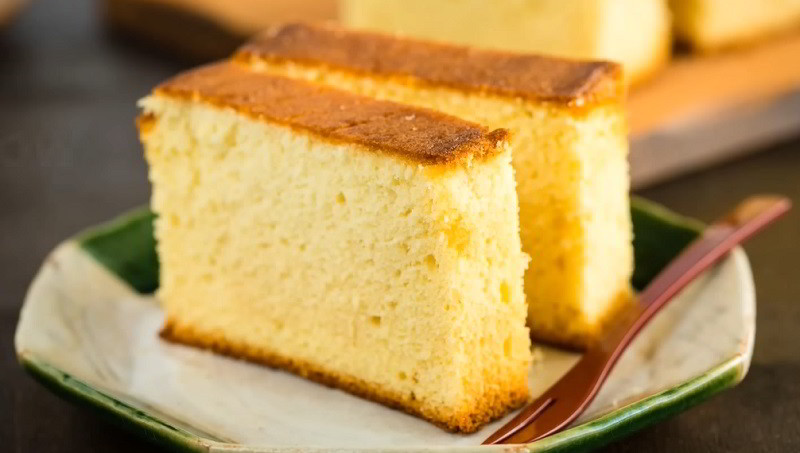
Castella is a traditional Japanese dessert that originated in Nagasaki during the 16th century, and has since become a popular sweet treat throughout Japan. This sponge cake-like dish is characterized by its moist and fluffy texture, as well as its simple yet delightful taste. Castella is made from a handful of basic ingredients, including flour, sugar, eggs, and sometimes honey or mirin (sweet rice wine). The batter is carefully mixed and then baked in a rectangular mold, resulting in a golden-brown cake with a smooth and even surface. What sets Castella apart from other sponge cakes is its unique production process. The batter is beaten vigorously to incorporate air, which gives the cake its light and airy texture. This method also allows the cake to retain moisture, making it incredibly soft and tender. Castella is often enjoyed on its own, but it can also be paired with various accompaniments, such as whipped cream, fruits, or a dusting of powdered sugar. Some variations of Castella include matcha (green tea) or honey flavors, adding a touch of distinctiveness to this beloved Japanese sweet.
Baumkuchen
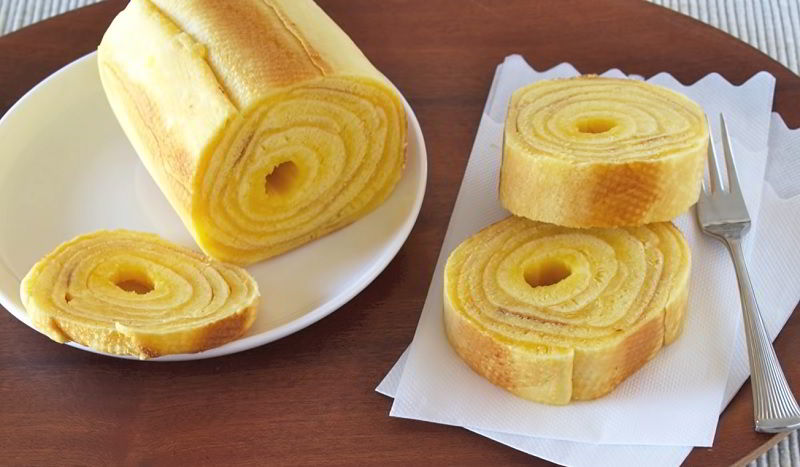
Japanese desserts and sweets are known for their delicate flavors, beautiful presentation, and attention to detail. One such dessert that perfectly embodies these qualities is the Baumkuchen. Baumkuchen, meaning "tree cake" in German, is a layered dessert that has become a popular sweet treat in Japan. It is made by pouring thin layers of cake batter onto a rotating spit, allowing each layer to cook and brown before adding the next. This process creates a unique ring-like pattern, resembling the rings of a tree trunk. The Baumkuchen is typically served sliced into individual portions, revealing its intricate layers. The cake itself is moist and buttery, with a slightly caramelized exterior. It is often dusted with powdered sugar or drizzled with chocolate for added sweetness. In Japan, Baumkuchen is enjoyed on various occasions, including weddings, birthdays, and holidays. It is also commonly found in specialty pastry shops and cafes.
Wagashi
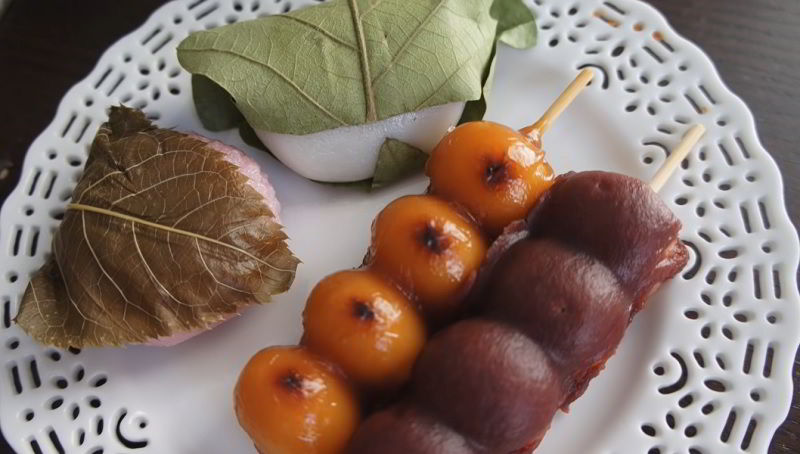
Wagashi is a traditional Japanese sweet dish that encompasses a wide variety of desserts and sweets. These delicate treats are known for their exquisite presentation, vibrant colors, and subtle flavors. Wagashi is often made using natural and seasonal ingredients, reflecting the changing seasons in Japan. One popular type of wagashi is mochi, a chewy rice cake made from glutinous rice flour. These are often filled with sweet bean paste, such as azuki or white bean paste, creating a delightful combination of textures and flavors. Another common wagashi is dorayaki, which consists of two fluffy pancake-like layers filled with sweet bean paste. Wagashi also includes beautiful fruit jellies, agar-based desserts, and yokan, a thick, sweet jelly made from red bean paste. These sweets are often shaped into intricate designs, such as flowers or animals, showcasing the skill and artistry of Japanese confectioners. Wagashi is not only enjoyed for its taste but also for its aesthetic appeal. It is often served with green tea during traditional tea ceremonies or as a delightful dessert after a meal.
Daifuku
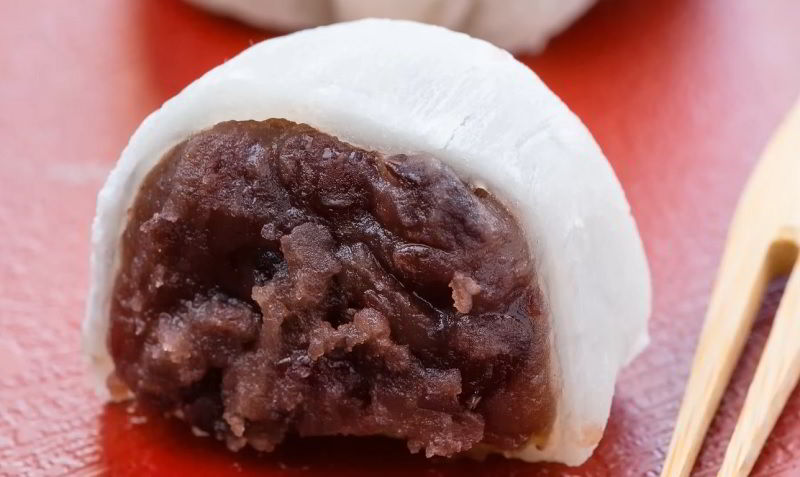
Daifuku is a traditional Japanese dessert that is loved for its soft and chewy texture. It consists of a small round mochi (glutinous rice cake) filled with a sweet filling, usually red bean paste called anko. The mochi is made by pounding glutinous rice into a smooth and pliable dough, which is then shaped into small balls. The anko filling is typically made from boiled azuki beans that are sweetened and mashed into a smooth paste. However, there are also variations of daifuku that include other fillings such as matcha (green tea) or fruit flavors. Daifuku is not only delicious but also visually appealing, with its vibrant colors and smooth texture. It is often served as a special treat during Japanese festivals or as a dessert at tea ceremonies. The combination of the soft and slightly chewy mochi with the sweet and flavorful anko filling creates a delightful taste experience that is loved by people of all ages.
Pocky
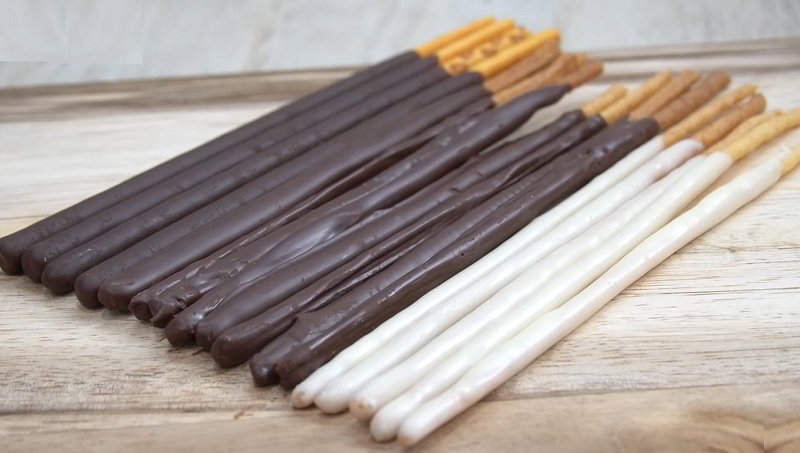
Pocky is a popular Japanese snack created by the Ezaki Glico food company. It features biscuit sticks coated with various flavors. The name "Pocky" is derived from the Japanese word "pokkiri," mimicking the sound of the snack being snapped. Initially, Pocky was chocolate-coated, but over time, variations like almond and strawberry coatings were introduced. Today, the product line offers a wide range of flavors including milk, mousse, matcha (green tea), honey, banana, cookies and cream, strawberry, and coconut.
Dorayaki
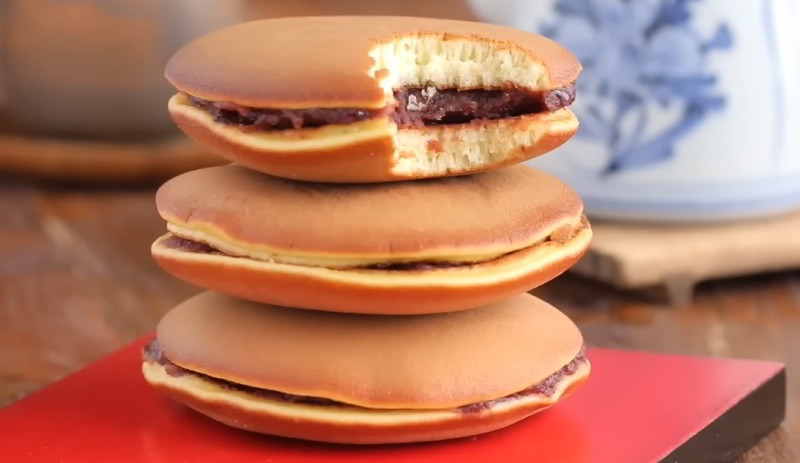
Dorayaki is a traditional Japanese dessert that consists of two small pancake-like patties sandwiching a sweet filling in the center. These golden brown pancakes are made from a mixture of flour, sugar, eggs, and baking powder, creating a fluffy and slightly chewy texture. The most common filling for Dorayaki is a sweet red bean paste called "anko," made from boiled and mashed azuki beans combined with sugar. Anko has a rich and creamy consistency that perfectly complements the soft pancakes. However, there are also variations available, including custard, chocolate, matcha, and even fruit fillings. The softness of the pancakes combined with the sweetness of the filling creates a harmonious and satisfying experience.
Konpeitō
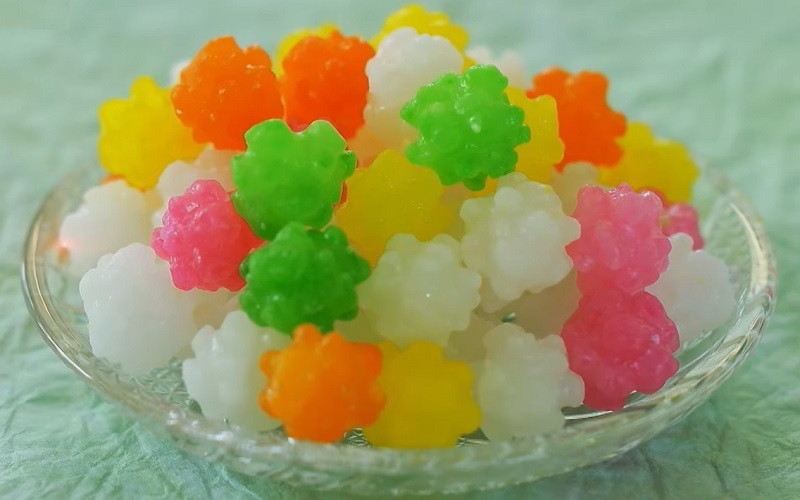
Konpeitō is a traditional Japanese candy that has been enjoyed for centuries. These delicate, colorful sweets are made by coating sugar syrup on small pieces of sugar. The process of making konpeitō is a labor of love, as it requires skill and patience to create the perfect texture and shape. The candies are usually small, round, and have a hard, crystallized exterior. The sugar coating comes in a variety of vibrant colors, making konpeitō an eye-catching treat. Each piece is carefully crafted to have a unique shape and texture, resulting in a visually appealing dish. Konpeitō is not only appreciated for its appearance but also for its sweet, sugary flavor. The candies dissolve slowly in the mouth, releasing bursts of sweetness with each bite.
Imagawayaki
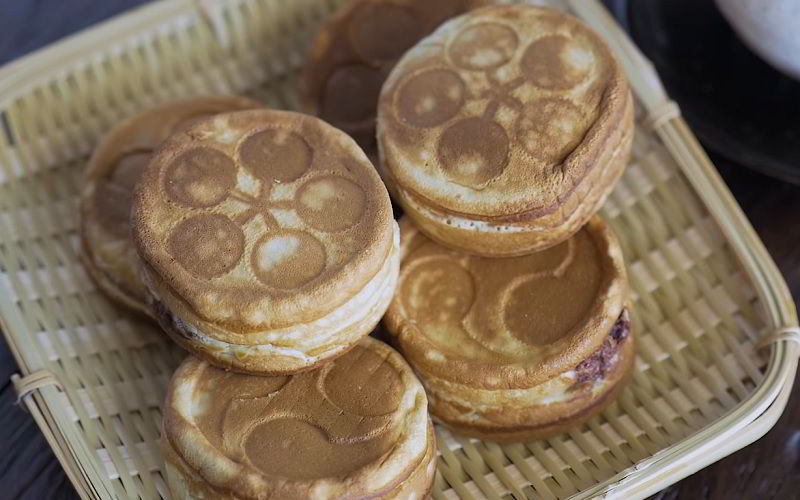
Imagawayaki is a traditional sweet dish that consists of two fluffy pancakes with a sweet filling in between. The pancakes are made from a batter composed of flour, sugar, eggs, and baking powder, resulting in a soft and slightly crispy texture. The filling of Imagawayaki can vary, but some common choices include red bean paste (anko), custard, chocolate, or even savory options like cheese or meat. The red bean paste filling, known as anko, is the most traditional and widely enjoyed option. It has a sweet and slightly earthy flavor that pairs perfectly with the pancakes. Imagawayaki is typically cooked in a special iron griddle with half-circle molds, which gives the dessert its distinct shape. The griddle is heated, and the batter is poured into the molds, followed by the chosen filling. Once cooked, the pancakes are golden brown and have a delightful aroma.
Melonpan
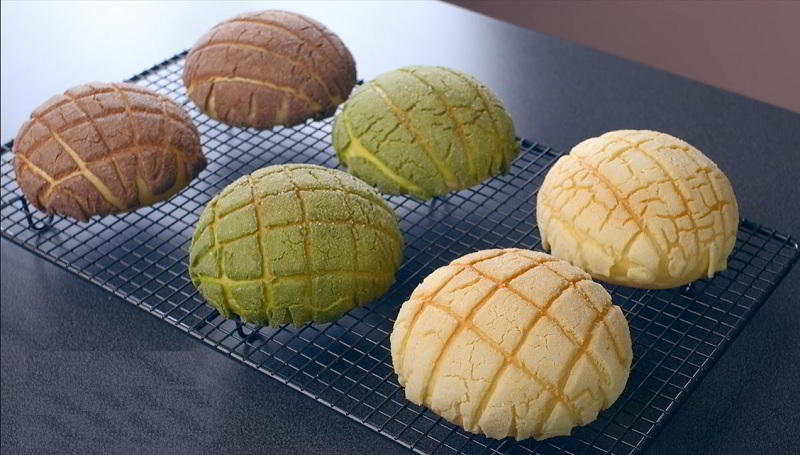
Japanese desserts are known for their delicate flavors, beautiful presentation, and unique textures. One popular dessert that exemplifies these qualities is Melonpan. Melonpan, also known as melon bread, is a sweet bun that is characterized by its crispy outer layer and soft, fluffy interior. Despite its name, Melonpan does not typically have a melon flavor. However, it gets its name from the distinct pattern on its crust, resembling the skin of a cantaloupe melon. Melonpan takes this traditional sweet bun to the next level by adding a variety of delectable toppings and fillings. It can be filled with various ingredients, such as custard, chocolate, or matcha cream, which adds a delightful creaminess to the already delicious bread. Some variations even include fresh fruits or ice cream as a topping, creating a refreshing and indulgent dessert.
Mochi Ice Cream
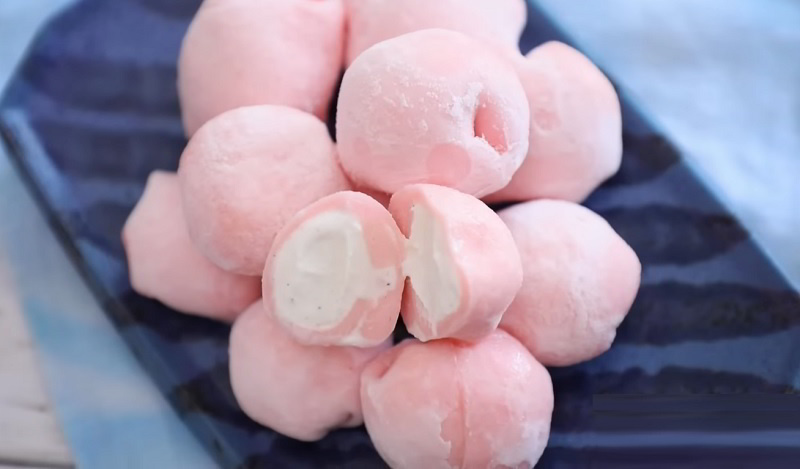
Mochi ice cream is a delightful and popular Japanese dessert that combines the chewy texture of traditional mochi with the creamy sweetness of ice cream. It is a unique and mouthwatering treat that has gained popularity worldwide. The preparation of mochi ice cream involves wrapping a small ball of ice cream with a layer of soft and sticky mochi rice cake. The mochi is made from glutinous rice flour, which gives it its distinct chewy and elastic texture. The ice cream filling can vary in flavors, including green tea, strawberry, mango, and chocolate, among others. Each piece is typically bite-sized, making it convenient and enjoyable to eat. Mochi ice cream has a delightful balance of textures and flavors. The soft and slightly sweet mochi exterior complements the rich and creamy ice cream filling, creating a harmonious combination that is both refreshing and indulgent.
Manjū
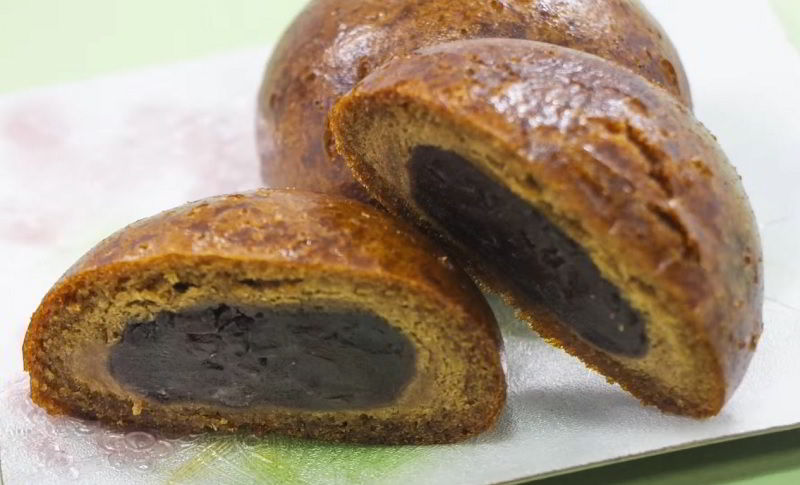
Manjū is a traditional Japanese dessert that is loved for its delicate texture and delightful fillings. This sweet treat is made by steaming a soft, slightly chewy dough made from flour, rice powder, kudzu, and buckwheat. The dough is then filled with various sweet fillings, such as red bean paste (anko), matcha green tea, chestnut, or even fruit preserves. The shape of manjū can vary, but it is commonly a round or oval shape with a pleated design on top. The outer layer of the dough is usually soft and slightly sticky, giving it a unique texture that is both enjoyable to touch and eat. Its flavors range from subtly sweet to rich and indulgent, depending on the filling used. The red bean paste filling is the most popular and traditional choice, giving manjū a sweet and earthy flavor.
Warabimochi
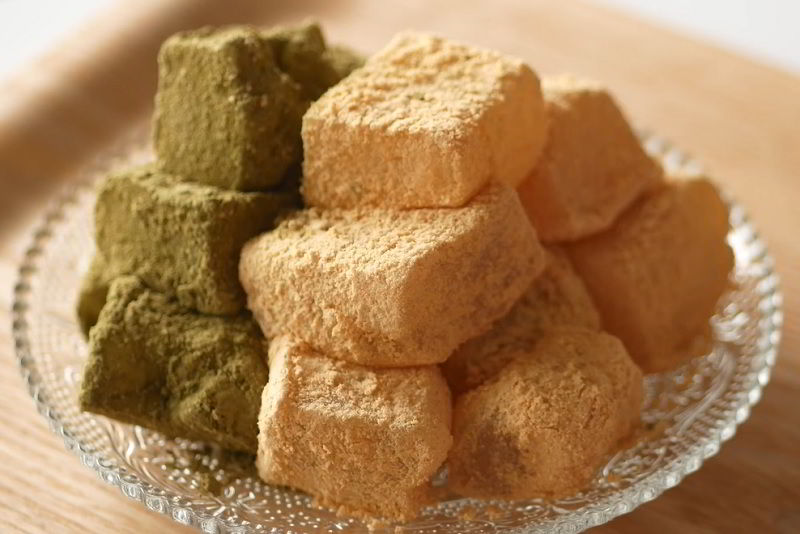
Warabimochi is a unique sweet treat made from bracken starch, which gives it a delightfully chewy and jelly-like texture. Warabimochi is often served with a generous sprinkling of kinako, a roasted soybean flour, and drizzled with kuromitsu, a rich and sweet black sugar syrup. The dish is a perfect balance of flavors and textures. The bracken starch provides a refreshing and slightly earthy taste, while the kinako adds a nutty and toasty flavor. The kuromitsu brings a deep and caramel-like sweetness that enhances the overall experience. Warabimochi is not only delicious but also visually appealing. The soft and translucent jelly-like cubes, coated in the golden kinako and glistening kuromitsu, create an enticing presentation that is hard to resist.
Kangidan
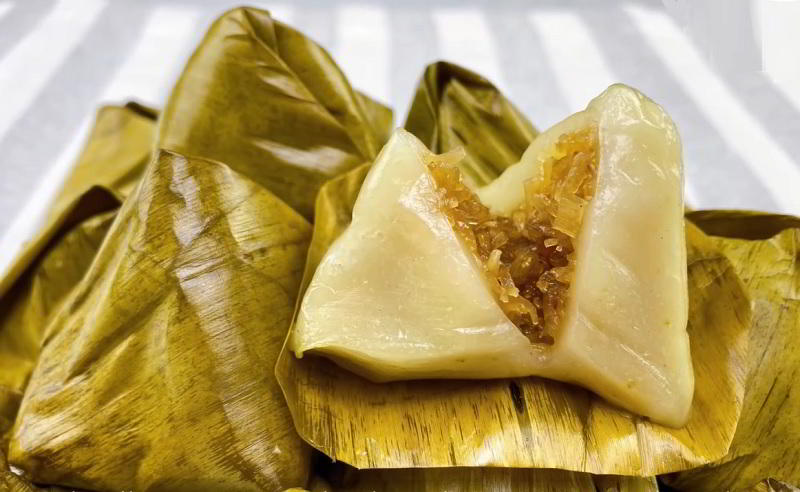
Kangidan is a Japanese sweet similar to the Indian sweet modak. Kangidans made from curds, honey, and red bean paste. These ingredients are encased in a dough made from roasted flour, which is then shaped into a bun-like form before undergoing deep-frying.
Karumeyaki
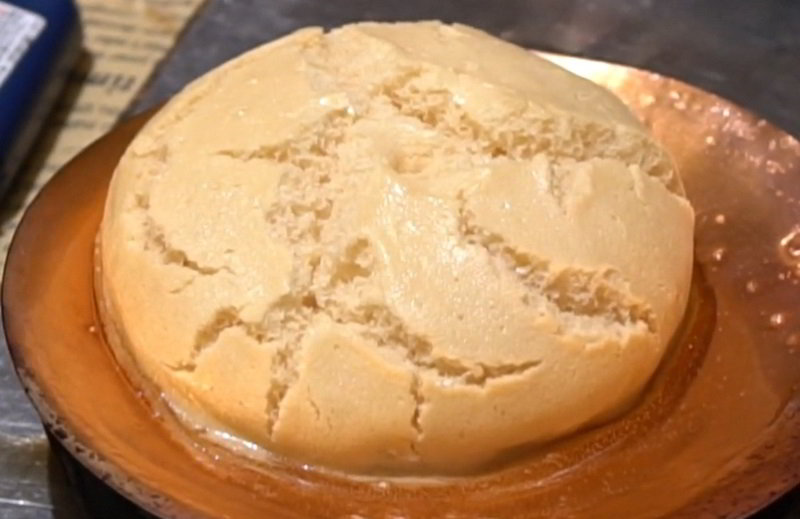
Karumeyaki is the Japanese name for honeycomb toffee. It is made by heating sugar and adding baking soda, which causes it to foam and expand, creating a light and airy texture reminiscent of honeycomb. The toffee is then molded into bite-sized pieces, providing a satisfying crunch with each bite. What sets honeycomb toffee apart is its unique balance of sweet and savory flavors. The caramelized sugar gives it a rich sweetness, while the addition of baking soda imparts a subtle hint of saltiness. This combination creates a harmonious taste that is truly addictive.
Yōkan
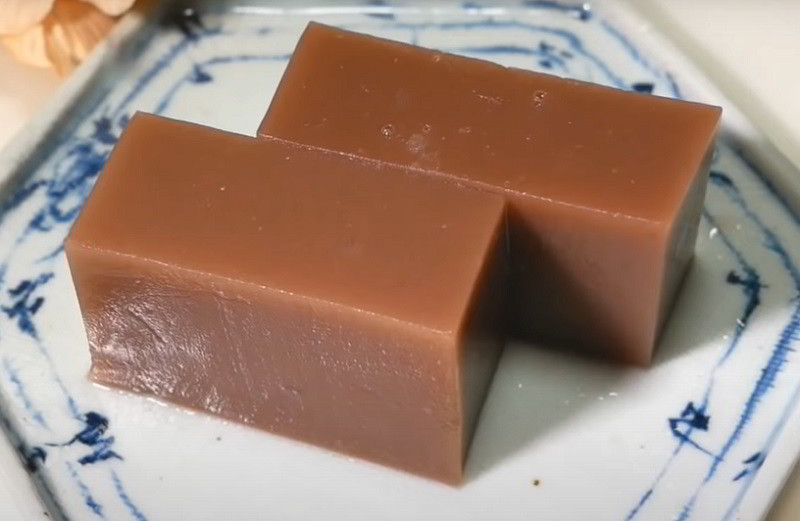
Yōkan is a traditional Japanese sweet dish that has been enjoyed for centuries. It is a type of jelly-like dessert made from red bean paste, agar-agar (a type of seaweed-derived gelatin), and sugar. Yōkan comes in various shapes, sizes, and flavors, offering a delightful range of options for dessert lovers. The texture of yōkan is firm yet smooth, allowing it to be easily sliced into bite-sized pieces. The most common flavor is azuki yōkan, which is made from sweetened red bean paste. However, there are also other flavors available, such as matcha (green tea) yōkan, chestnut yōkan, and even fruit-infused yōkan. Yōkan is often served chilled during the hot summer months, making it a refreshing treat to beat the heat.
Senbei
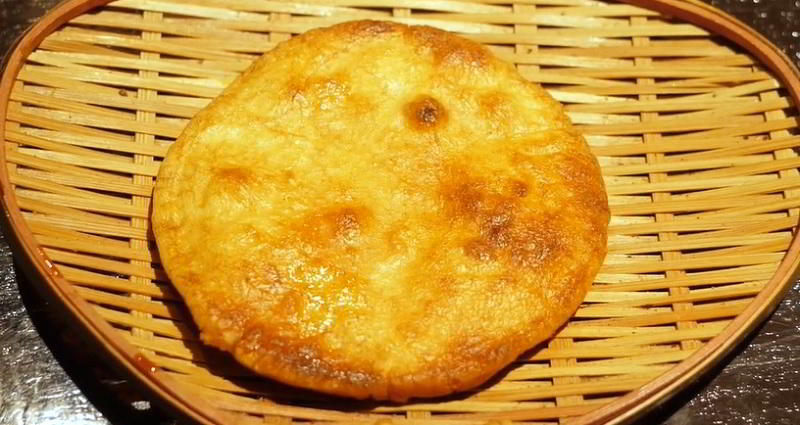
Senbei is a traditional Japanese rice cracker that has been enjoyed for centuries. Made from glutinous rice, the crackers are typically baked or grilled to perfection, resulting in a satisfying crunch. They come in various shapes and flavors, ranging from savory to sweet. Sweet senbei, known as "ame-senbei," are coated with a sugary glaze or syrup, often flavored with soy sauce, matcha, or black sugar. These sweet varieties are loved for their delicate balance of sweetness and umami. Some senbei are also filled with sweet fillings like red bean paste or chocolate. On the other hand, savory senbei are seasoned with soy sauce, seaweed, sesame, or other spices, offering a savory and addictive snack. Senbei is not only enjoyed as a standalone treat but is also used in various desserts. It can be crushed and used as a topping for ice cream, incorporated into mochi, or even used as a base for cheesecakes and pies.
Arare
-1706083919.jpg)
Arare is a traditional Japanese sweet treat that is popularly enjoyed as a snack or dessert. These bite-sized delights are made by coating small, round rice crackers with a sweet and savory glaze. The crackers are typically made from glutinous rice, giving them a chewy texture that contrasts perfectly with the crunchy exterior. The glaze used to coat the arare can vary in flavors, offering a wide range of options to suit different palates. Some common flavors include soy sauce, sesame, and seaweed, which add a delicious umami taste to the crackers. Other variations may incorporate ingredients such as matcha (green tea powder) or kinako (roasted soybean flour) for a unique twist.
Kakigōri
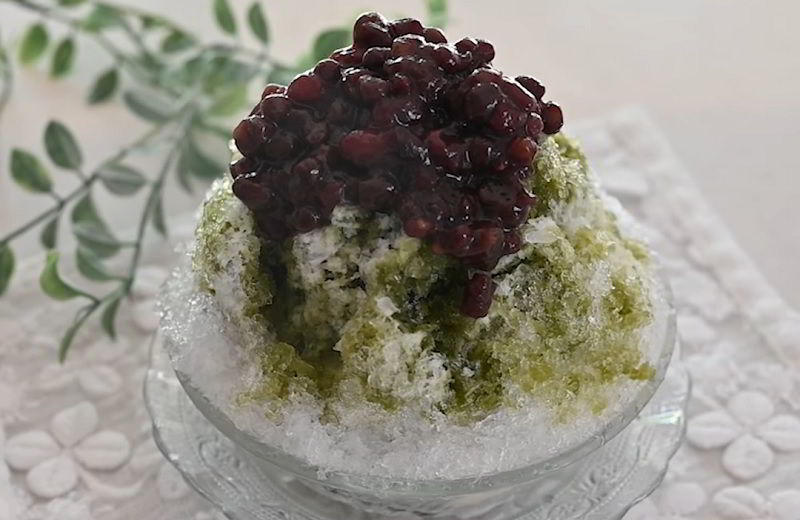
Kakigōri is a is a refreshing dish made from shaved ice and flavored syrups. The ice is finely shaved to create a delicate and fluffy texture that melts in your mouth. Kakigōri is often served with a variety of toppings and sauces, such as sweetened condensed milk, fresh fruit, or even traditional Japanese ingredients like red bean paste or green tea syrup. These toppings add a burst of flavor and texture to the already delightful dish.
Japanese Cheesecake
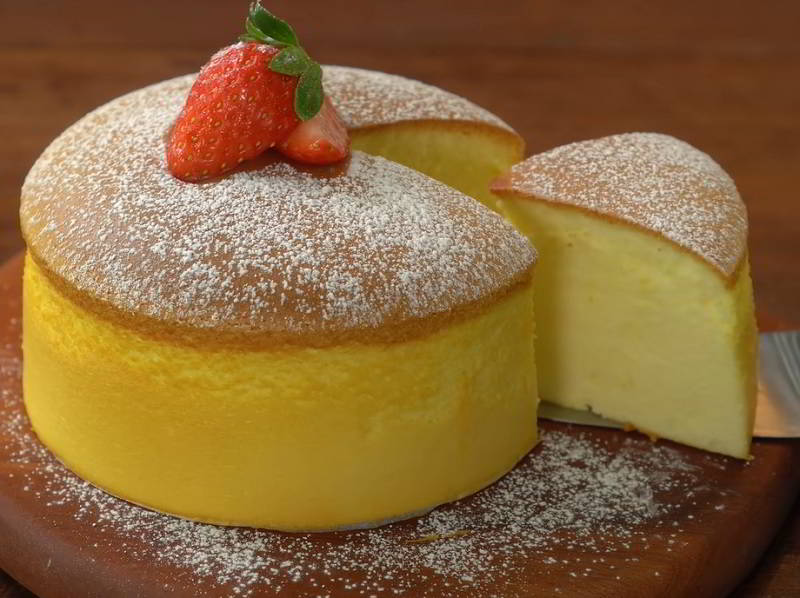
Japanese cheesecake combines the rich and creamy goodness of classic cheesecake with the light and fluffy texture of a soufflé. Japanese cheesecake is made with a few key ingredients such as cream cheese, eggs, sugar, and flour. The addition of whipped egg whites gives it a airy and spongy texture, while the cream cheese provides a smooth and velvety taste. The cake is typically baked in a water bath to ensure even cooking and prevent cracking. What sets Japanese cheesecake apart is its subtle sweetness and delicate flavor. It is not overly sweet like its Western counterparts, allowing the natural flavors to shine through. It often has a hint of citrus or vanilla, adding a refreshing twist to the traditional cheesecake taste. Japanese cheesecakes are often served plain, dusted with powdered sugar, or topped with fresh fruits.
Anpan
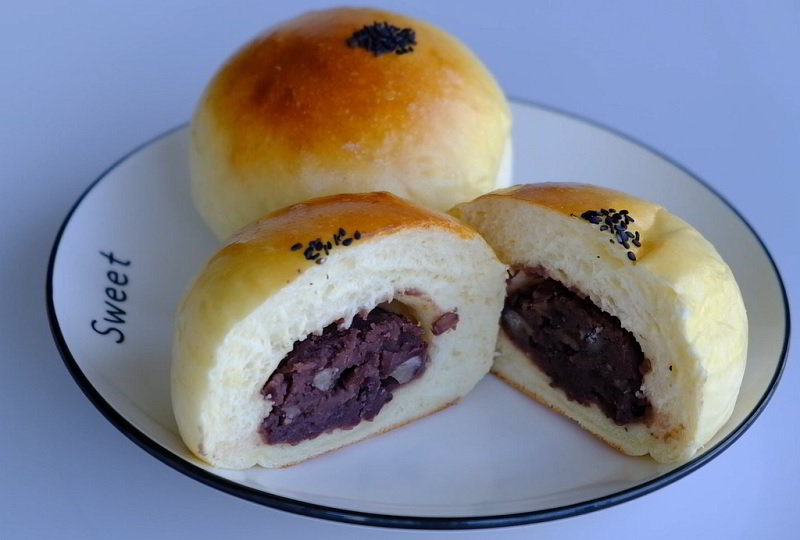
Anpan is a traditional Japanese dessert which consists of a soft, sweet bread bun filled with a sweet red bean paste called anko. The bread used to make anpan is light and fluffy, with a slightly sweet taste that complements the richness of the anko filling. The anko filling is made from cooked azuki beans that are mashed and sweetened with sugar. It has a smooth texture and a sweet, nutty flavor that is incredibly satisfying. Anpan comes in various sizes, shapes, and flavors. Some variations include matcha (green tea) anpan, chestnut anpan, and even savory anpan filled with ingredients like curry or cheese. Each one offers a unique twist on the classic anpan, adding even more variety to this beloved dessert.
Monaka
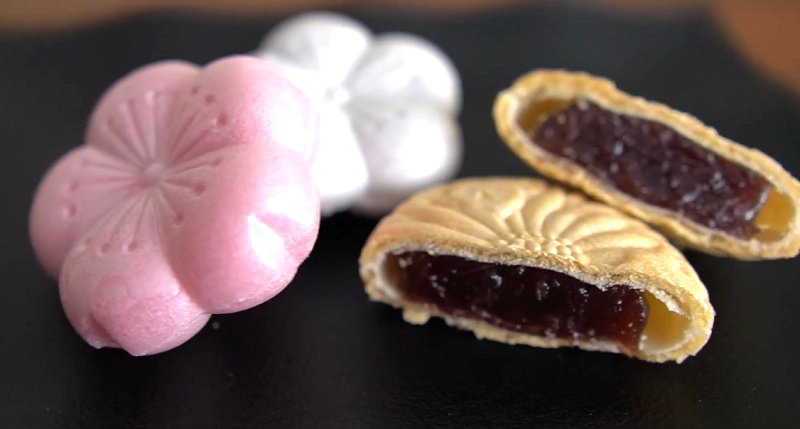
Monaka is a traditional Japanese dessert that consists of two crispy wafers made from glutinous rice flour, sandwiching a sweet filling. The wafers are thin and light, with a delicate crispiness that adds a satisfying texture to the dish. The filling can vary, but some popular options include red bean paste (anko), matcha-flavored cream, chestnut paste, or even fruit preserves. One of the unique aspects of monaka is its versatility. It can be enjoyed as a standalone treat, or it can be incorporated into other desserts such as ice cream sandwiches or parfaits.
Sakuramochi
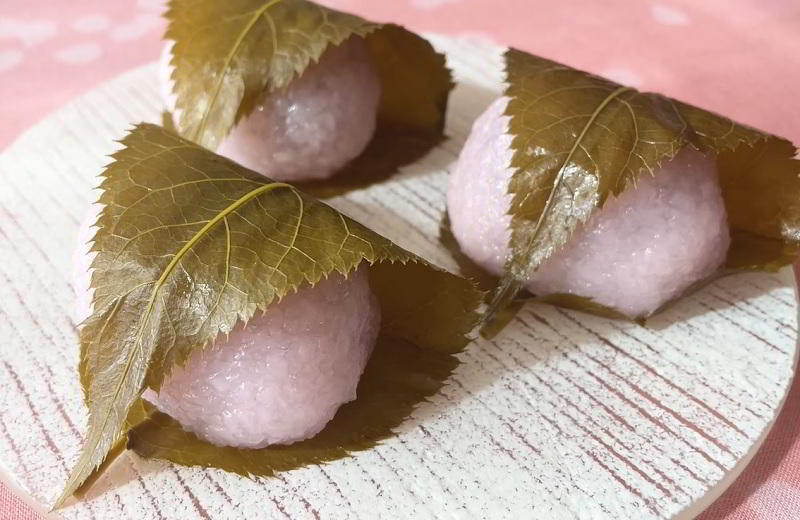
Sakuramochi is a traditional Japanese dessert made with a glutinous rice cake called mochi, which is filled with a sweet red bean paste known as anko. What makes sakuramochi unique is its beautiful pink color, resembling the blossoms of the cherry tree, which is why it is often enjoyed during the spring season. The mochi is wrapped in a pickled cherry leaf, adding a subtle tangy flavor to the sweet filling. The combination of the soft and chewy texture of the mochi with the creamy anko creates a delightful contrast. The cherry leaf also adds a touch of elegance to the dish, making it a popular choice for special occasions and celebrations. Sakuramochi represents the beauty and delicacy of Japanese desserts. Its delicate flavors and charming appearance perfectly capture the essence of cherry blossoms in both taste and presentation.
Yatsuhashi
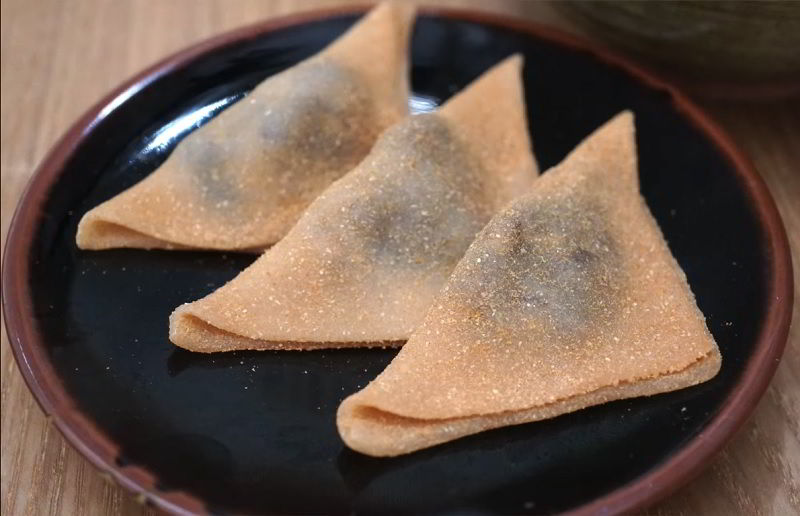
Yatsuhashi is a Japanese confection sold mainly as a souvenir snack. It is one of the best known products of Kyoto. It is made from glutinous rice flour, sugar, and cinnamon. Baked, it is similar to senbei. The shape of the hard crackers resembles a Japanese harp or koto, or a bamboo stalk cut lengthways.
Anmitsu
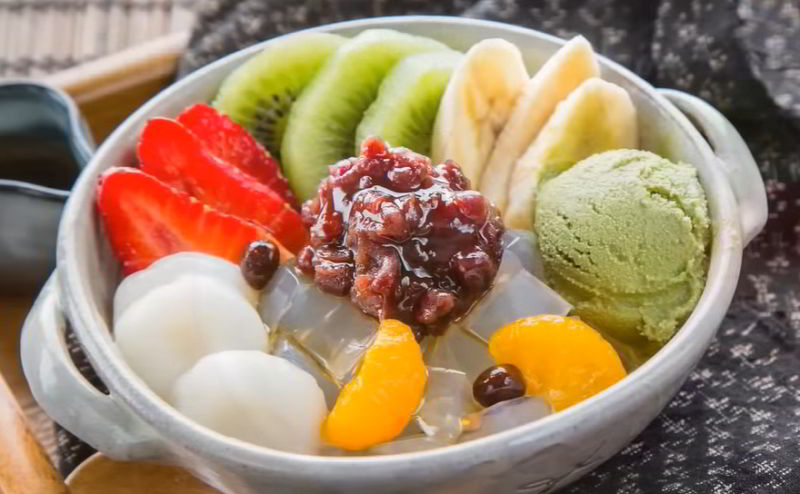
Anmitsu typically consists of cubes of agar jelly, sweet azuki bean paste, assorted fruits such as melon, peach, and strawberry, and a dollop of vanilla ice cream, all served in a bowl. The agar jelly is made from red algae and has a firm yet delicate texture that adds a refreshing element to the dessert. The rich and smooth azuki bean paste provides a sweet and earthy flavor, complementing the sweetness of the fruits. The fruits, often chosen for their vibrant colors and natural sweetness, add a juicy and fresh element to the dish. Anmitsu is usually served with a sweet syrup made from sugar and water, which is poured over the ingredients, enhancing the overall sweetness and tying the flavors together. The dish is also often garnished with a sprinkle of roasted soybean flour or a cherry on top, adding an extra touch of flavor and visual appeal.
Tokyo Banana
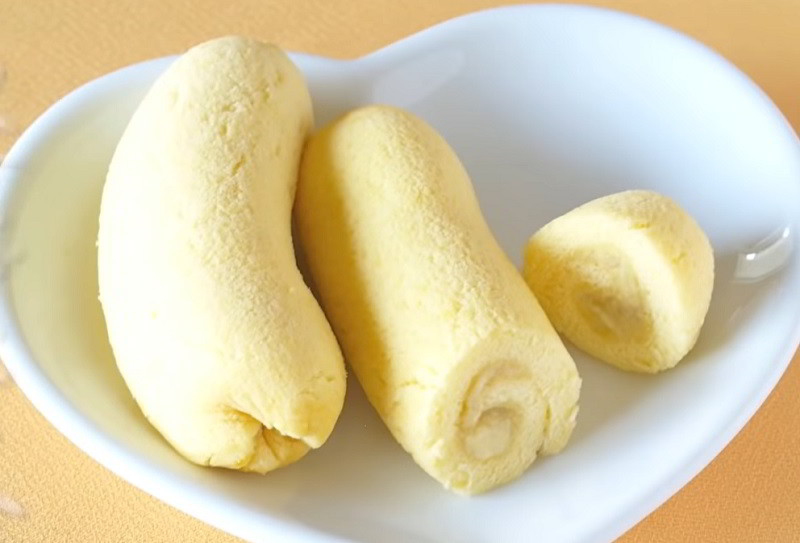
Tokyo Banana is a delightful combination of a sponge cake filled with a creamy banana custard. The cake itself is made with premium ingredients, ensuring a light and moist texture that melts in your mouth. The banana custard filling adds a burst of flavor, with a creamy and fruity taste that perfectly complements the cake. Tokyo Banana comes in a variety of flavors, including the classic banana, chocolate, and even seasonal flavors like strawberry or matcha.
Shiroi Koibito
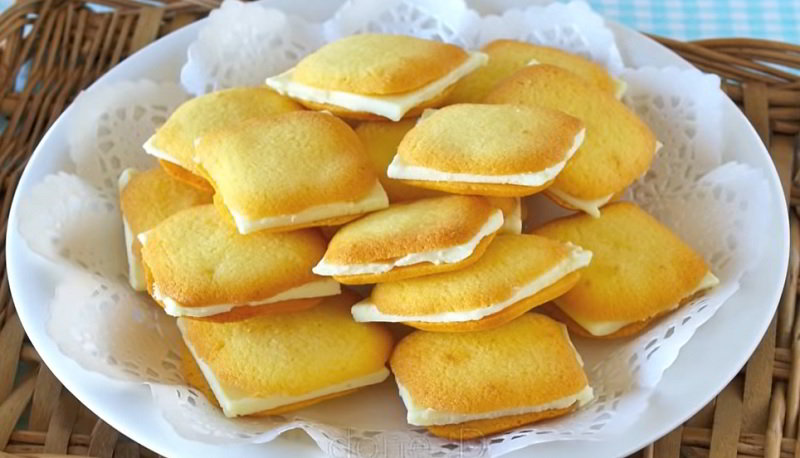
Shiroi Koibito, which translates to "White Lover" in English, is a beloved Japanese sweet treat. The Shiroi Koibito dish consists of two thin, buttery cookies sandwiched together with a layer of smooth, creamy white chocolate. The cookies are light and crispy, providing the perfect contrast to the rich sweetness of the white chocolate filling. The white chocolate itself is made from high-quality ingredients, resulting in a velvety texture and a subtle vanilla flavor. What makes the Shiroi Koibito dish even more special is its elegant packaging. The cookies are individually wrapped in a distinctive blue and white box, adorned with a lovely illustration of a couple in traditional Japanese attire.
Shiruko
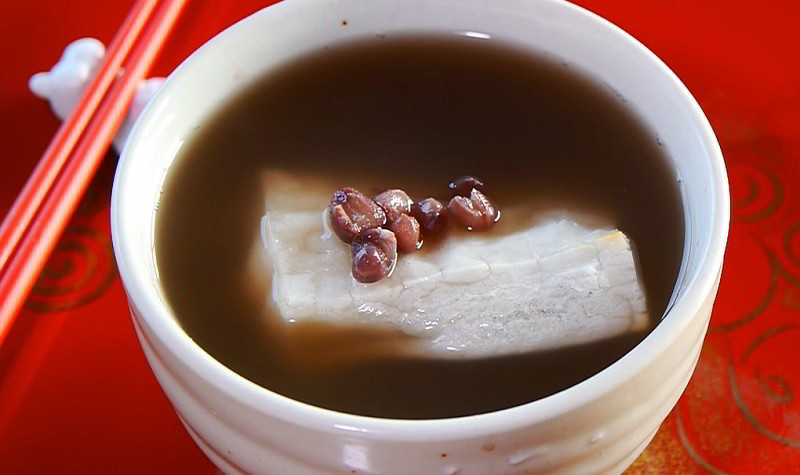
Shiruko, also known as azuki bean soup, is a popular traditional Japanese dessert that is enjoyed all year round. This delightful dish consists of a sweet red bean soup served with small mochi (glutinous rice cakes). The key ingredient of Shiruko is the azuki beans, which are boiled and sweetened to create a smooth and creamy soup. The beans are simmered until they are tender and then mashed to achieve a velvety texture. The addition of sugar enhances the natural sweetness of the beans, resulting in a comforting and satisfying dessert. The mochi in Shiruko adds a chewy and slightly sticky texture to the dish. These small rice cakes are made from glutinous rice flour and are often shaped into small balls before being served in the soup. The combination of the sweet bean soup and the chewy mochi creates a delightful contrast of flavors and textures.
Keiran Somen
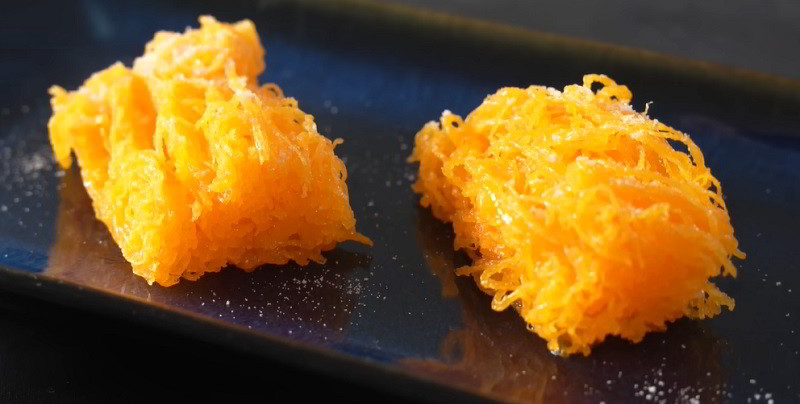
Keiran Somen is inspired from the Portuguese dessert 'Fios de ovos'. It is a sweet and indulgent dessert made from strands of egg yolks cooked in a sugar syrup. To prepare Keiran Somen, egg yolks are whisked and then strained through a fine sieve to create fine threads. These threads are then cooked in a sugar syrup until they become translucent and glossy. The resulting dessert is soft, sweet, and almost ethereal in texture. Keiran Somen is often served as a topping or filling for other Japanese desserts, such as dorayaki (sweet pancakes) or anmitsu (jelly and fruit dessert). It adds a touch of elegance and sweetness to these already delicious treats.
Green Tea Ice Cream
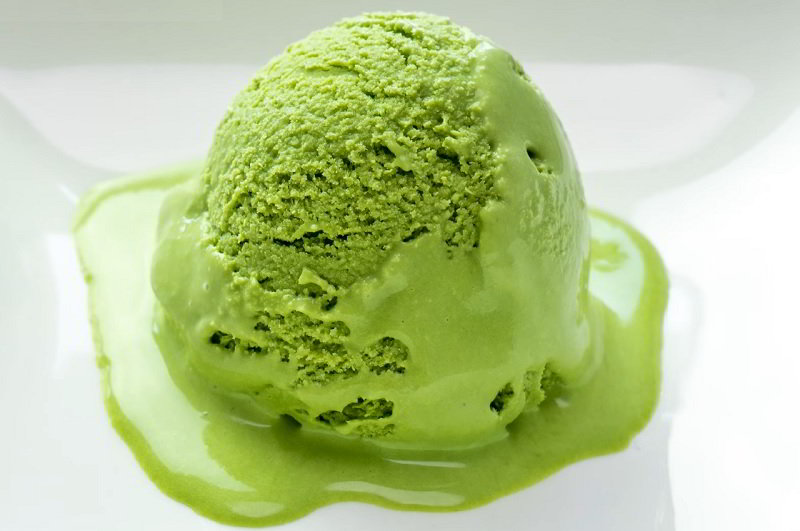
Green tea ice cream is very popular in Japan. Made with the finest matcha powder, this sweet treat offers a harmonious balance of bitter and sweet notes. The vibrant green color of the ice cream is visually appealing and reflects the natural essence of the matcha tea. The smooth and velvety texture of the ice cream provides a luxurious and indulgent experience for the taste buds. The rich and earthy taste of the matcha is complemented by a subtle sweetness, creating a perfect contrast of flavors.
Momiji Manjū
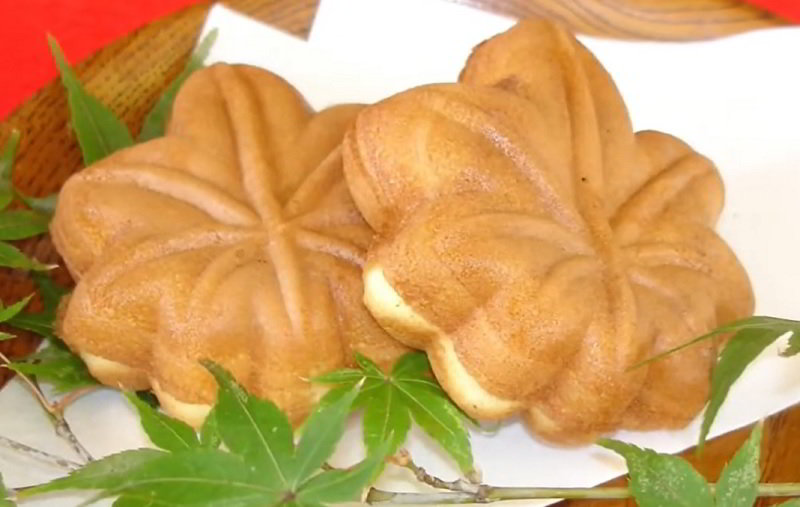
Momiji manjū is a traditional Japanese dessert that originated in Hiroshima. It is a type of wagashi, which refers to traditional Japanese sweets. Momiji manjū is named after the momiji or maple leaf, which is known for its vibrant red color during autumn in Japan. The dessert is made by enclosing a sweet filling, typically made of red bean paste or white bean paste, inside a soft and fluffy dough. The dough is then shaped like a maple leaf, giving it its distinctive appearance. Momiji manjū can also be filled with other flavors such as matcha (green tea), chocolate, custard, or fruit.
Tokoroten
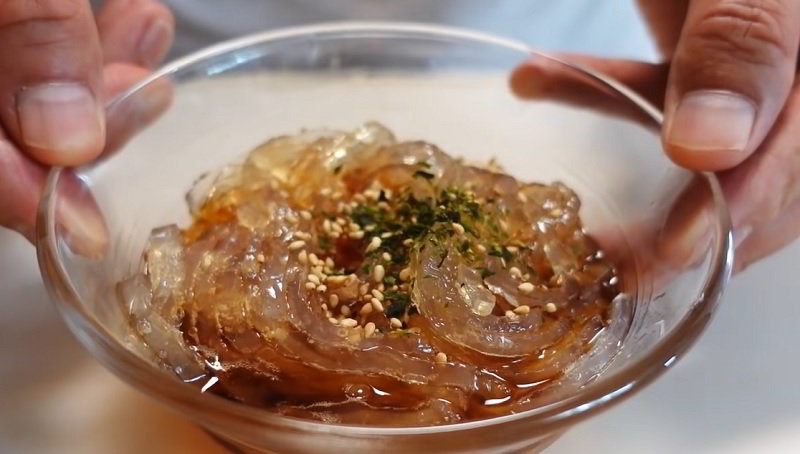
Tokoroten is a traditional Japanese dessert made from agar agar, a type of gelatin derived from seaweed. The dish is typically served cold and has a jelly-like consistency. The process of making Tokoroten begins by boiling the agar agar in water until it dissolves completely. The mixture is then poured into molds and allowed to set and cool. Once it solidifies, the Tokoroten is cut into thin, noodle-like strips using a special machine. The noodles are usually served in a clear, sweet broth made from sugar, soy sauce, and vinegar, which adds a delightful balance of flavors to the dish. Sometimes, fruit juices or matcha powder are added to the mixture for additional flavoring.
Botamochi
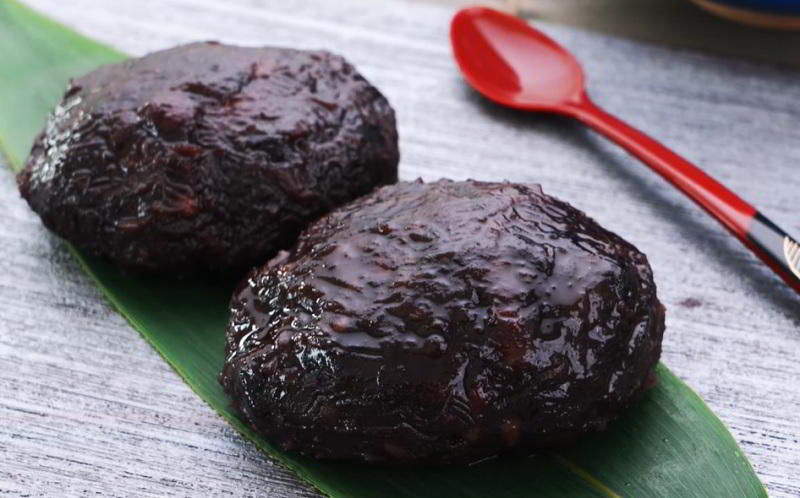
Botamochi is a traditional Japanese dessert that consists of a round mochi (glutinous rice cake) filled with sweet azuki bean paste. The mochi itself is made from pounded rice, giving it a soft and chewy texture. The name "botamochi" is derived from the Japanese word "botan," meaning peony flower, as the shape of the mochi resembles the flower petals. The dish is often garnished with a cherry blossom leaf, adding to its aesthetic appeal. Botamochi is not overly sweet, allowing the natural flavors of the azuki bean paste to shine through.
Karintō
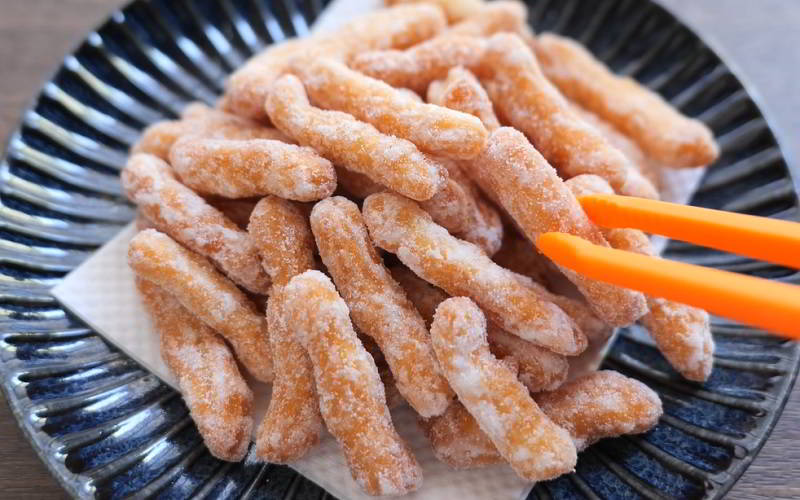
Karintō is a traditional Japanese sweet snack that is loved for its crispy texture and delightful sweetness. It is made by deep-frying a mixture of flour, yeast and brown sugar. It exhibits a dark brown, textured surface and comes in the shape of a small pillow or a short cylinder.
Coffee Jelly
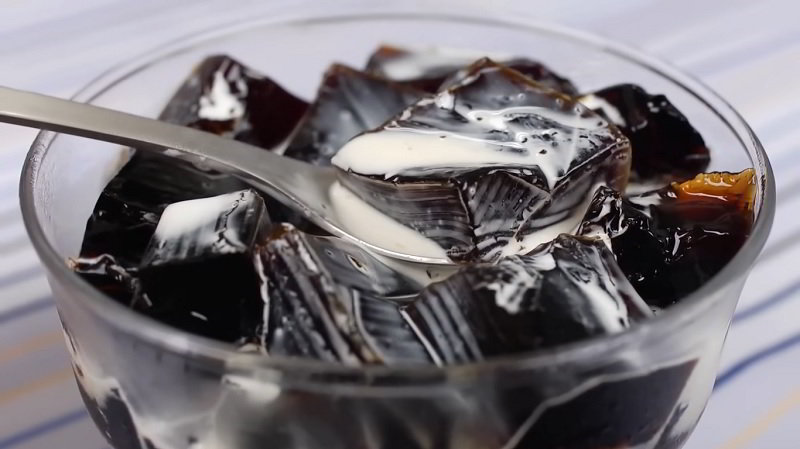
Coffee Jelly is a popular dessert that combines the love for coffee and jelly. This dish is a simple yet delightful treat that satisfies the palate. Coffee jelly is made by dissolving gelatin in strong brewed coffee, sweetened with sugar. The mixture is then chilled until it sets into a firm jelly texture. The resulting dessert is served in various forms, such as cubes, slices, or even as a parfait topping. The flavor of coffee jelly is rich and smooth, with a slight bitterness from the coffee that is perfectly balanced by the sweetness of the sugar.
Kibi Dango
-1708067367.jpg)
Kibi dango is a traditional Japanese sweet treat that originated in Okayama Prefecture. These delightful little dumplings are made from kibi, a type of millet grain, which gives them a unique texture and flavor. To make kibi dango, the millet is first cooked and then ground into a fine powder. This powder is then mixed with glutinous rice flour and water to form a dough. The dough is then shaped into small balls and steamed until they become soft and chewy. Kibi dango can be enjoyed on its own or served with a variety of toppings. Some popular choices include kinako (roasted soybean flour), black sesame powder, or sweet azuki bean paste.
Kuzumochi
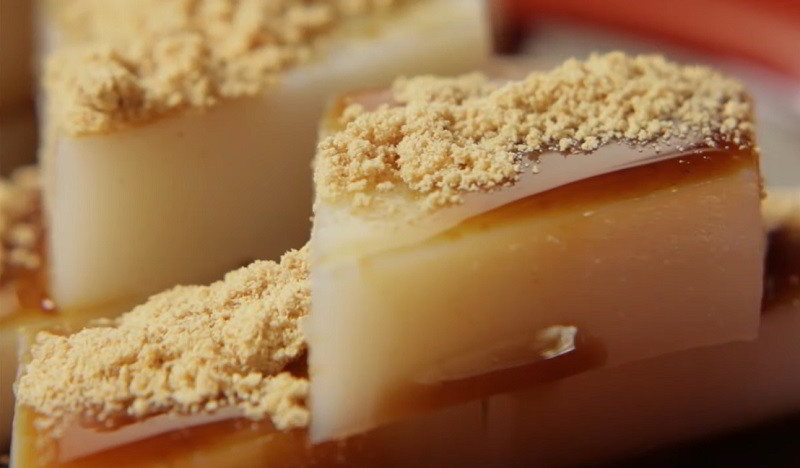
Kuzumochi is a traditional Japanese dessert made from mochiko, a glutinous rice flour, and kuzuko, a starch made from the root of the kuzu plant. This combination creates a unique texture that is both chewy and jelly-like. The preparation of kuzumochi involves mixing mochiko and kuzuko with water and sugar, then steaming the mixture until it solidifies. The resulting cake is then cut into small, bite-sized pieces and coated with kinako, a roasted soybean powder, to add a nutty flavor. Some variations of kuzumochi also include a sweet syrup made from kuromitsu, a type of dark sugar syrup. The taste of kuzumochi is subtly sweet and has a delicate, melt-in-your-mouth texture. It is often enjoyed as a light and refreshing dessert, especially during the hot summer months.
Kusa Mochi
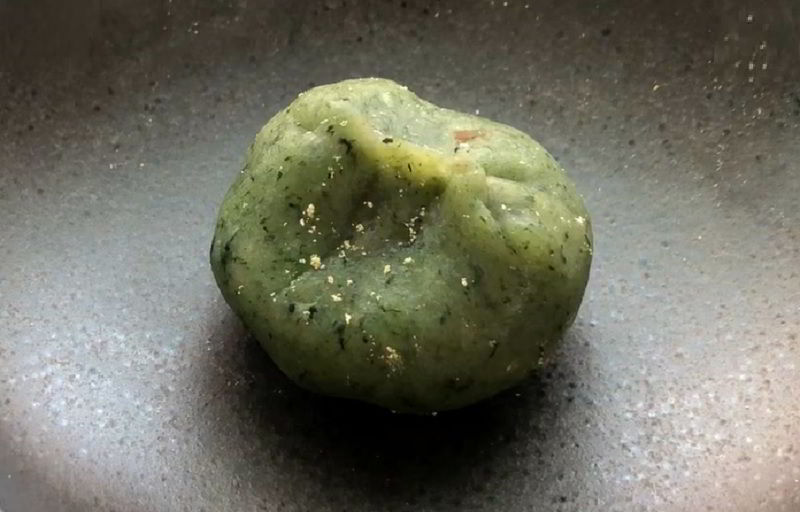
Kusa mochi is a traditional Japanese dessert that is both visually appealing and delicious. This unique dish consists of small, bite-sized mochi balls that are made with kusa, or mugwort, giving them a vibrant green color. The mochi is made by pounding glutinous rice until it becomes sticky and elastic, and then mixed with kusa powder to create the distinctive flavor and color. The kusa mochi is often enjoyed with a dusting of kinako, a sweet roasted soybean flour, which adds a nutty taste and enhances the overall texture. Another common accompaniment is a drizzle of kuromitsu, a thick, sweet black sugar syrup, which provides a delightful contrast to the mild bitterness of the kusa mochi.
Higashi
-1708075335.jpg)
Higashi is a traditional Japanese dessert that is known for its delicate and intricate designs. It is a type of dry sweet that is typically made from rice flour, sugar, and starch. Higashi comes in a variety of shapes and colors, each representing different symbols and meanings. These sweets are often served during tea ceremonies or as gifts on special occasions. The process of making higashi involves meticulously shaping the dough into various forms using molds or hand-molding techniques. The designs can range from simple geometric patterns to intricate seasonal motifs such as cherry blossoms or autumn leaves. The finished higashi is then dried to achieve a crunchy and brittle texture. Despite their ornate appearance, higashi are not overly sweet. They have a subtle sweetness that is balanced with a hint of bitterness, making them a perfect accompaniment to Japanese green tea. The delicate flavors and beautiful presentation of higashi reflect the Japanese aesthetic of simplicity and attention to detail.
Zunda-mochi
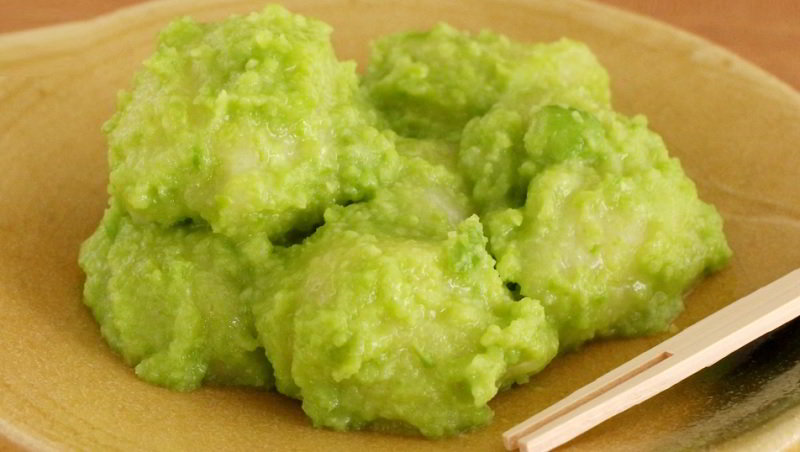
Zunda-mochi is a traditional Japanese dessert that originated in the Tohoku region, known for its vibrant green color and delightful taste. This sweet treat consists of chewy mochi, a sticky rice cake, topped with a generous serving of zunda, a sweetened edamame paste. The mochi is made by pounding glutinous rice until it becomes a smooth and elastic dough, which is then shaped into small round or square pieces. The zunda paste is prepared by grinding boiled edamame beans and blending them with sugar, resulting in a creamy and slightly nutty flavor. Zunda-mochi is often served during special occasions and festivals, particularly in the spring when edamame beans are in season. The vibrant green color of the zunda paste is not only visually appealing but also represents the freshness and vitality of nature. This delightful combination of soft, chewy mochi and sweet, creamy zunda paste creates a harmonious balance of textures and flavors. Zunda-mochi is a beloved dessert in Japan, cherished for its unique taste and cultural significance.
Uirō
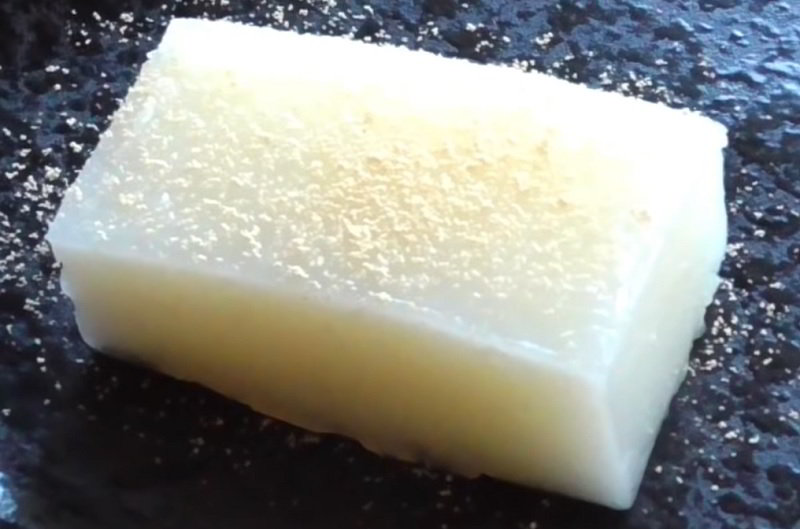
Uirō is a is a type of mochi, a chewy rice cake made from glutinous rice flour. Uirō has a smooth and soft texture that is different from other types of mochi. The dish is typically made by mixing rice flour with sugar and water, then steaming it until it becomes a gelatinous dough. The dough is then shaped into small bite-sized pieces or molded into various shapes, such as flowers or animals. Uirō can be enjoyed as is or coated with kinako (roasted soybean flour) for added flavor.
Amanattō
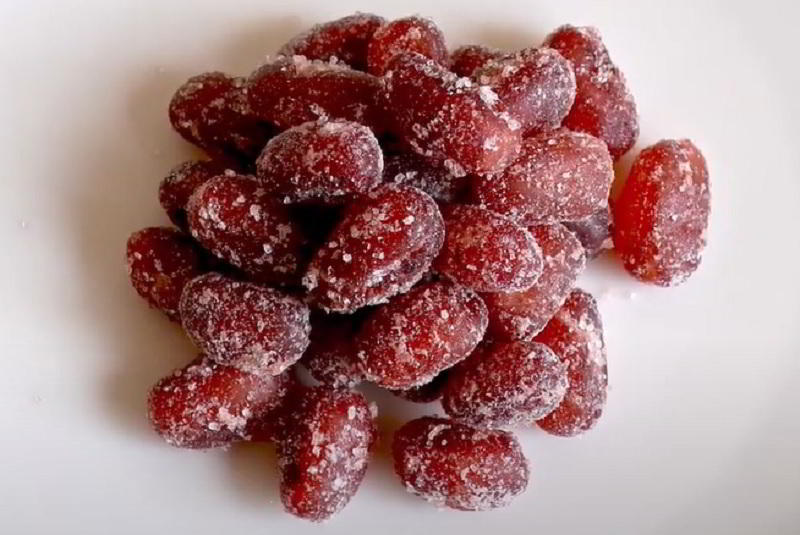
Amanattō is a traditional Japanese sweet dish that has been enjoyed for centuries. These bite-sized treats are made from azuki beans, which are cooked and then coated in a thick sugary syrup. The beans are simmered until they become tender and infused with a delicate sweetness. The syrup is made by combining sugar and water, which is then heated until it thickens to a sticky consistency. Amanattō is known for its vibrant colors, as it is often dyed with natural food coloring derived from ingredients like green tea or sakura (cherry blossoms). This adds a visually pleasing element to the dessert, making it a feast for the eyes as well as the taste buds.
Goheimochi
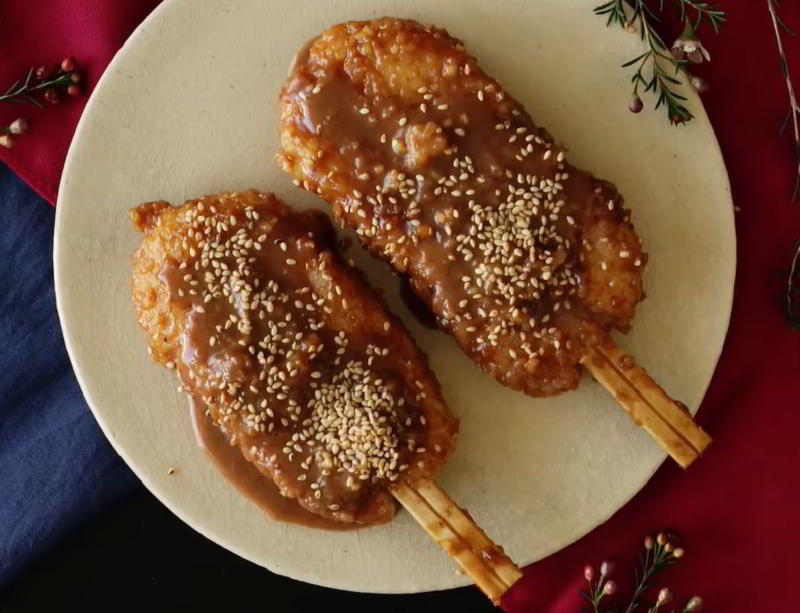
Goheimochi is a traditional Japanese sweet made from pounded sticky rice, grilled on skewers, and then coated with a savory and slightly sweet miso sauce. The process of making Goheimochi starts with cooking and pounding the sticky rice until it becomes a smooth and elastic dough. The dough is then shaped into small balls and grilled on skewers until they develop a crispy outer layer. Once grilled, the Goheimochi is glazed with soy sauce and sugar.
Honey Toast
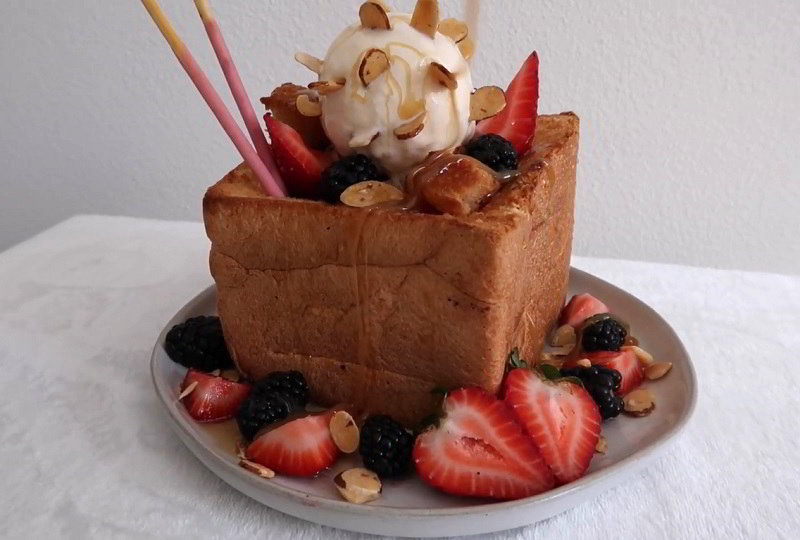
Honey toast, also referred to as Shibuya toast, brick toast, or hanito, is a Japanese dessert with its origins in Shibuya, dating back to the Japanese asset price bubble era. The key ingredient in honey toast is bread, typically pain de mie. The bread is hollowed out and cut into small cubes, then caramelized by brushing them with a mixture of butter and honey before baking until they turn golden. Once baked, the cubes are layered back into the loaf, which can then be filled with a variety of toppings such as macerated fruits, toasted nuts, different syrups, or whipped cream. To complete the dish, it's often served with a scoop of ice cream on top.
Kashiwa Mochi
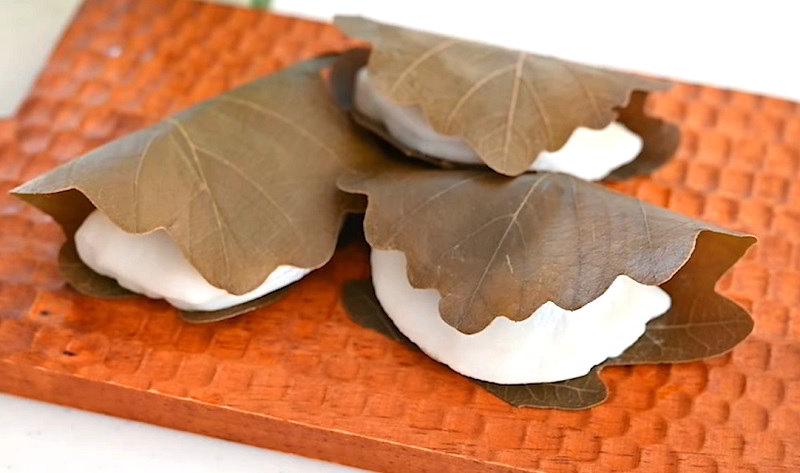
Kashiwa mochi is a traditional Japanese sweet that is often enjoyed during the celebration of Children's Day on May 5th. This delectable dish consists of a sweet rice cake (mochi) filled with a sweet red bean paste (anko), and wrapped in an oak leaf (kashiwa). The oak leaf not only adds a beautiful touch to the presentation but also imparts a subtle aroma and flavor to the mochi. The mochi itself is soft and chewy, while the anko filling provides a smooth and sweet contrast. The combination of textures and flavors creates a delightful experience for the taste buds.
Karukan
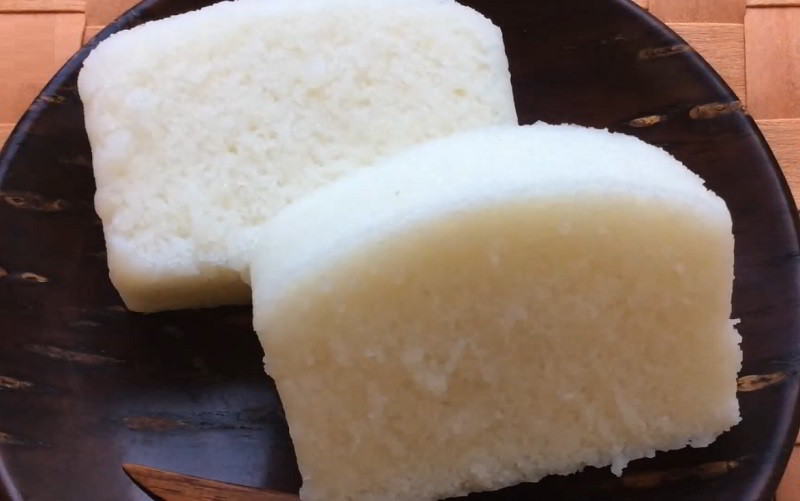
Karukan is a traditional Japanese dessert that originated in the Kagoshima prefecture. It is a sweet and chewy dish that is made from karukan rice flour powder, sugar, and grated Japanese yam. After combining the blended ingredients with water, the mixture undergoes kneading and steaming. The result is a soft, elastic, white sponge-like texture. The dish has a unique texture that is soft, yet slightly firm, and it is often shaped into small rectangular pieces.
Hishi Mochi
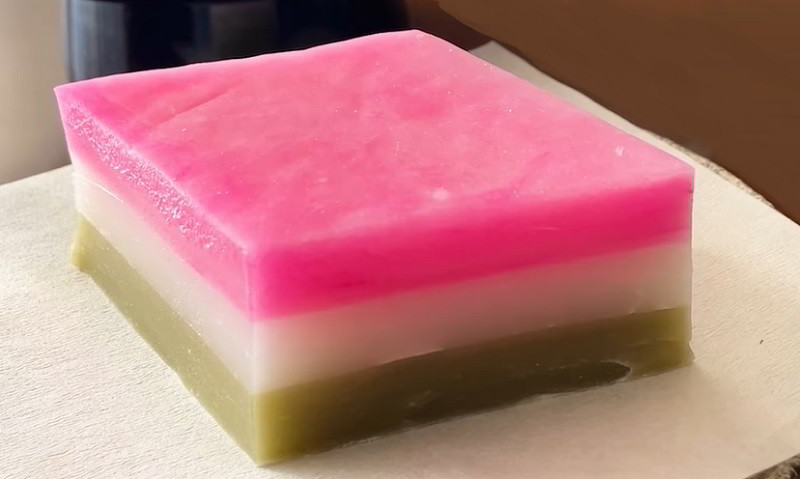
Hishi mochi is a sweet, chewy rice cake made from glutinous rice, also known as mochigome. The dish is named after its diamond-shaped appearance, with multiple layers of different colors. These layers are made from various ingredients such as red bean paste, green tea paste, and sometimes even fruit or nuts. Each layer is carefully stacked on top of each other, creating a visually stunning treat. Hishi mochi is often enjoyed during special occasions and celebrations, such as New Year's and Hinamatsuri (Girls' Day). It is believed to bring good luck and prosperity to those who eat it. The texture of Hishi mochi is soft and chewy, thanks to the glutinous rice used in its preparation.
Hanabiramochi
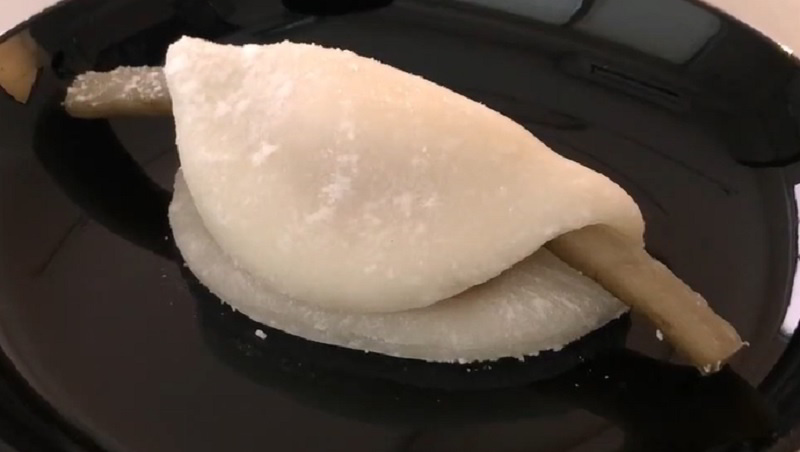
Hanabiramochi is a traditional Japanese dessert that is not only visually stunning but also deliciously sweet. This delicate dish consists of a thin layer of mochi, a chewy rice cake, filled with sweet red bean paste and folded into a beautiful petal shape resembling a flower blossom. The name "hanabiramochi" translates to "flower petal mochi," highlighting its artistic presentation. The mochi itself is made from glutinous rice flour, giving it a smooth and elastic texture. The red bean paste filling, known as anko, is made from azuki beans, which are cooked and sweetened. The combination of the slightly chewy mochi and the rich, sweet red bean paste creates a delightful contrast of textures and flavors.
Namagashi

Namagashi is a traditional Japanese dessert that is as visually appealing as it is delicious. These delicate sweet treats are often served with tea during the Japanese tea ceremony or as a part of special occasions and celebrations. Namagashi translates to "raw sweets" which refers to the use of fresh and seasonal ingredients. The main characteristic of Namagashi is its elegant presentation. Each piece is meticulously handcrafted to resemble natural elements such as flowers, leaves, or fruits. The colors and shapes are carefully chosen to reflect the changing seasons, making Namagashi a truly unique and artistic experience. The flavors of Namagashi vary depending on the ingredients used, but they tend to be light and subtly sweet. Common ingredients include red bean paste, matcha (green tea), agar-agar, and mochi (rice cake).
Crab Ice Cream
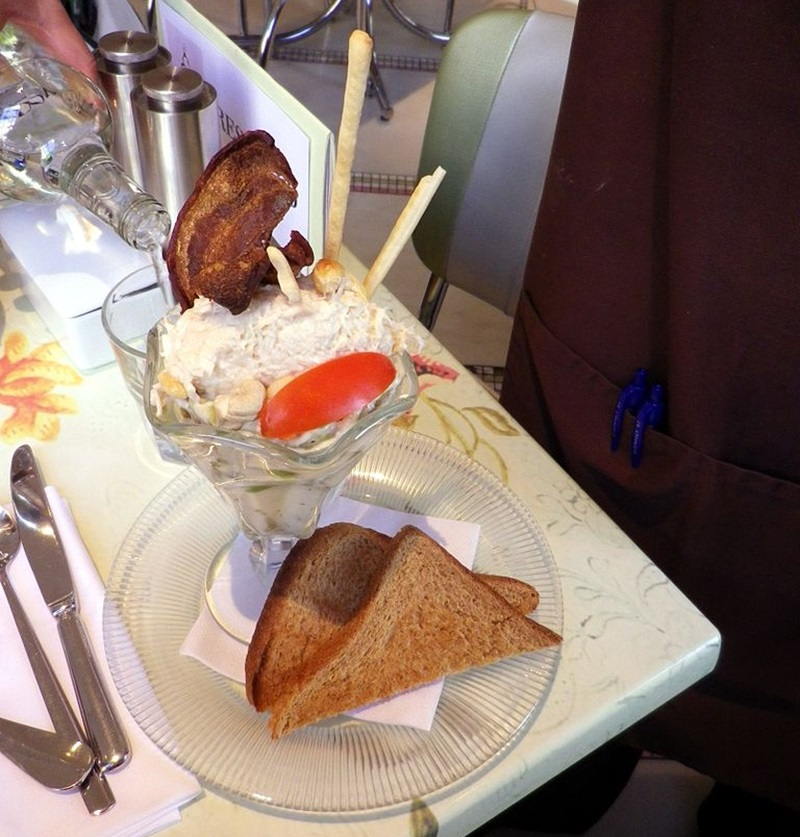
Crab ice cream is a unique sweet treat featuring the flavor of crab incorporated into ice cream. Originating from Hokkaido, Japan, this region is renowned for producing crab ice cream. The preparation involves creating a mixture using mainly crab stock (or sometimes prawns), along with a touch of skimmed milk powder, a dozen egg yolks, and sugar, which is then frozen to create the final product.
Chinsukō
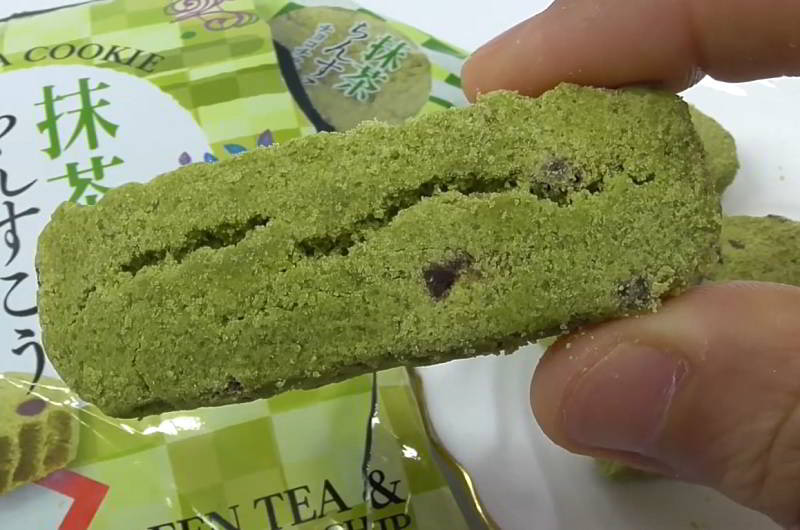
Chinsukō is a traditional Japanese dessert that originates from Okinawa, a southern island in Japan. This delectable sweet treat is primarily made of flour, sugar, and lard, giving it a unique texture and flavor. The dough is kneaded and shaped into small biscuits that are then baked until they become crispy and golden brown. Chinsukō biscuits are characterized by their delicate sweetness and buttery taste. These biscuits are often enjoyed with a cup of tea or as a snack on their own. They can also be incorporated into various dessert recipes, such as ice cream sandwiches or crumbled over puddings for added crunch.
Gyūhi
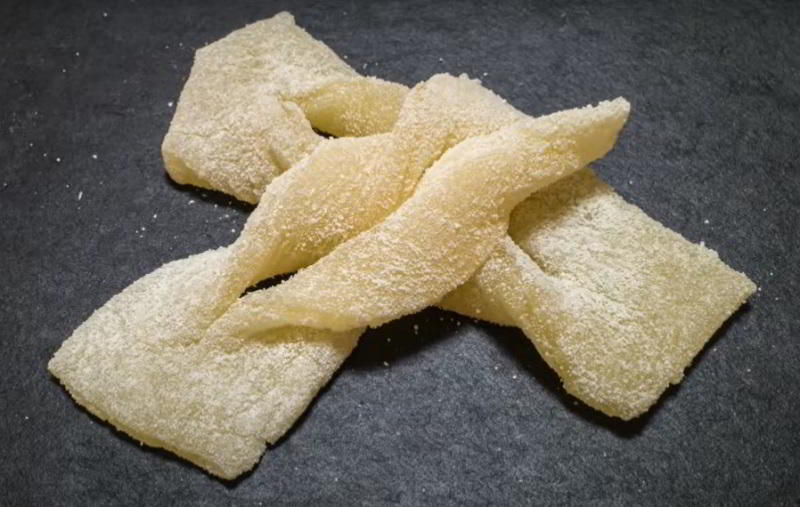
Gyūhi is a traditional Japanese dessert that is beloved for its soft and chewy texture. Made from glutinous rice flour, sugar, and water, Gyūhi has a unique and delightful consistency that sets it apart from other sweets. The dough is kneaded until it becomes smooth and elastic, then it is shaped into small bite-sized pieces. One of the most popular ways to enjoy Gyūhi is by dusting it with kinako, a roasted soybean powder, which adds a nutty flavor.
Hakuto Jelly
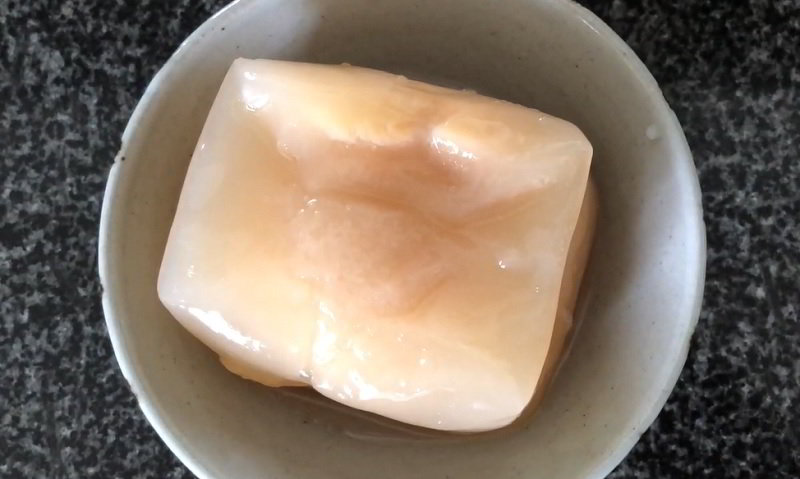
Hakuto jelly is made from Hakuto peaches, a variety of peach native to Japan, that are renowned for their sweet and juicy flavor. To create this exquisite dessert, the Hakuto peaches are peeled and then pureed to extract their natural sweetness. The puree is then mixed with gelatin and chilled until it sets into a soft and wobbly jelly consistency. The final dish is often served in elegant glassware or small bowls, allowing the vibrant orange color of the jelly to shine through. The jelly itself has a smooth and silky texture, while the peaches provide a burst of juicy sweetness.
Miyagegashi

Miyagegashi, a type of Japanese dessert and sweet, is renowned for its exquisite presentation and delicate flavors. These delectable treats are often purchased as souvenirs or gifts to bring back home, hence the name "miyage" meaning souvenir in Japanese. These desserts come in various forms, including wagashi (traditional Japanese sweets) and modern confections. Wagashi typically feature a combination of ingredients like mochi (glutinous rice cake), anko (sweet red bean paste), matcha (powdered green tea), and seasonal fruits. The flavors are subtle, with a perfect balance of sweetness and earthiness. Modern miyagegashi often incorporate Western influences, such as French pastries or chocolate. What sets miyagegashi apart is their stunning appearance. They are meticulously designed to resemble flowers, animals, or natural scenery. The colors are vibrant and the shapes are intricate, making each piece a work of art.
Ramune Candy
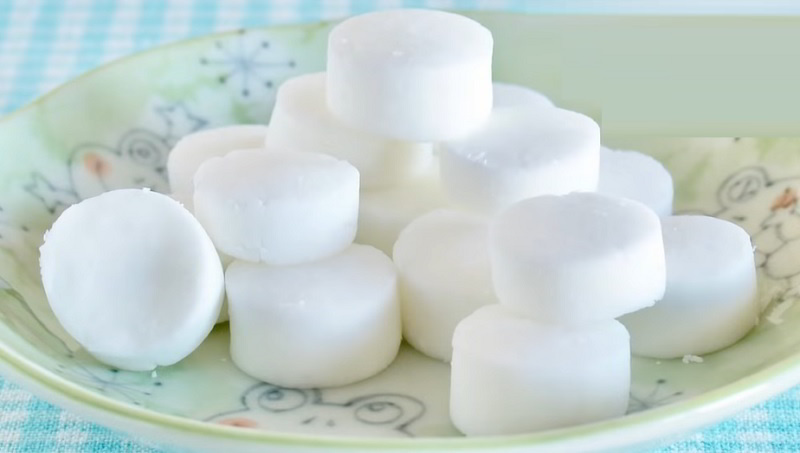
Ramune candy is a type of tablet candy originating from Japan. Typically, it consists of sugar mixed with a small amount of binding agent and other ingredients, which are compressed using a tableting machine. The term "ramune" doesn't have a strict definition, leading to various types of tablet candies being referred to as ramune. However, they share common characteristics such as being made from solidified powder, resulting in an opaque appearance, and containing some form of acidifier.
Beika
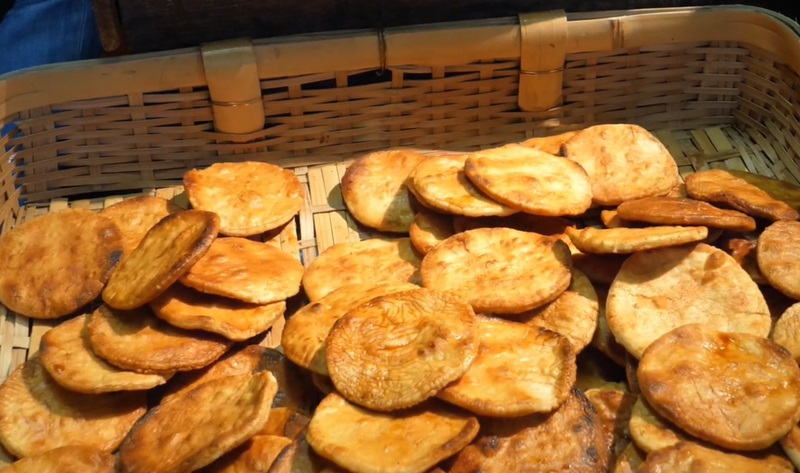
Beika is a dry Japanese snack made from rice, essentially functioning as a rice cracker. There are three main categories of Beika: senbei, arare, and okaki. The primary distinction among them lies in the type of rice flour used. Senbei is crafted using non-glutinous rice flour, while both arare and okaki are made from glutinous rice flour. Senbei, the largest of the three, offers both sweet and savory variations. Savory senbei is often coated with a mixture of soy sauce and mirin before cooking, while sweet senbei may contain ingredients like sugar, syrup, egg, and miso. Popular flavors include shoyu senbei (soy sauce flavored), okoge senbei (puffed rice), matcha senbei, sakura senbei, and nori senbei. Okaki, the second-largest type of rice crackers, involves preparing mochi rice cakes by steaming glutinous rice, pounding it into a paste, shaping it into buns, sun-drying for a week, and then cutting it into rice crackers. Arare, the smallest among the rice crackers, has a rounder shape compared to senbei and okaki, which are typically more circular.
Akumaki
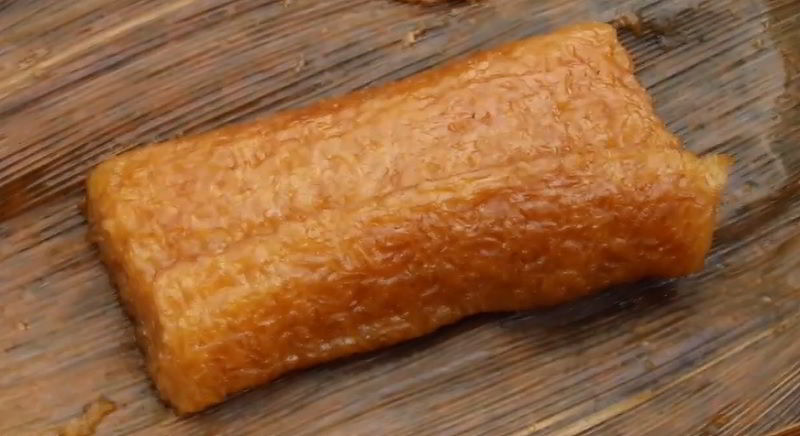
Akumaki is a traditional Japanese sweet, or wagashi, produced in Kagoshima, Miyazaki, and Kumamoto Prefecture during the Boys’ Festival on May 5th. It involves soaking glutinous rice, wrapped in bamboo leaves, in lye overnight. Due to its slightly bitter taste, it's commonly enjoyed with a mixture of blended sugar and toasted soybean flour (kinako), sometimes with a touch of salt or honey. Its distinctive flavor makes it an acquired taste among confections.
Suama
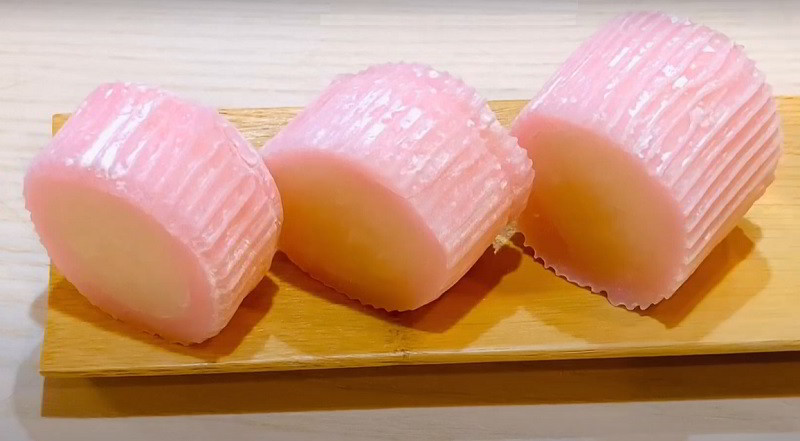
Suama, derived from the kanji representing "celebration" (su) and "sweet" (ama), is a traditional Japanese sweet crafted from non-glutinous rice flour, hot water, and sugar. This confection is distinguished by its vibrant red hue, achieved through the use of red food dye, symbolizing celebration in Japanese culture. The mixture is kneaded and can be shaped using a sushi rolling mat (sudare), resulting in a textured, slightly bumpy surface on the finished product.
Yubeshi
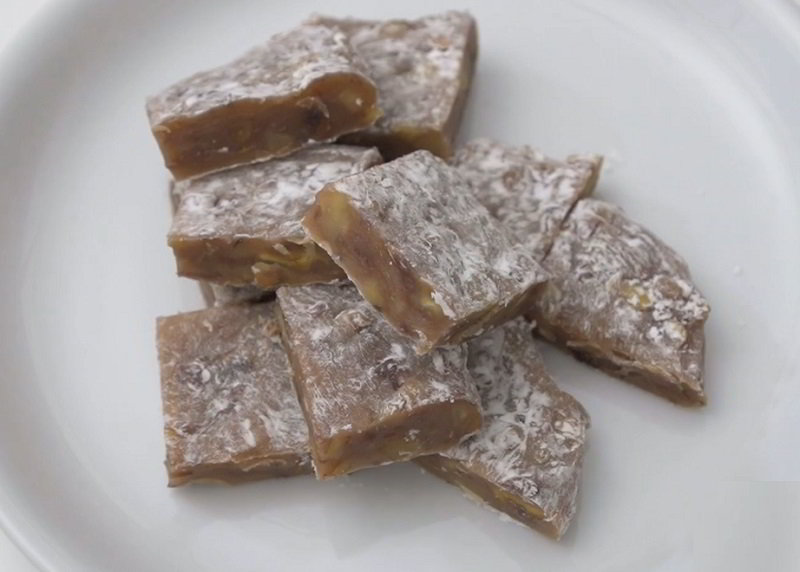
Yubeshi is a type of traditional Japanese confection, offering various flavors and shapes, with popular options being walnut or Japanese citrus, typically yuzu. The confection can be either round or square, but all variations share a base of sticky rice or rice flour, sugar, and soy sauce. The production process is intricate and time-consuming. It begins by cutting a circle from the top of the yuzu fruit, setting it aside, and then carefully removing the fruit and scraping away the white pith, leaving only the zest. The hollowed-out fruit is filled with a mixture that can range from plain mochiko flour to a blend of mochiko, shōyu, and spices. The reserved top of the fruit is placed back as a cap, and the whole fruit is steamed multiple times until it develops a shiny, brown appearance, and the mochi filling has fully set. With time, the texture of the yubeshi becomes firmer. Both the rind and filling of yubeshi are edible, and it can be served in various ways, such as thinly sliced on top of rice dishes or salads, or softened in warm soup dishes.
Mitsumame
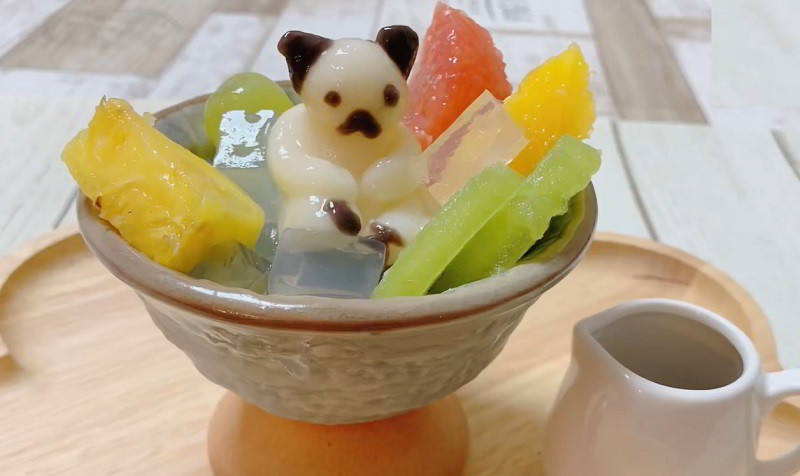
Mitsumame is a sweet treat is often served in a bowl or glass and consists of a colorful assortment of ingredients. The base of the dish is usually made from agar, a gelatin-like substance derived from seaweed, which gives it a unique texture. The mitsumame dish is topped with an assortment of sweet beans, such as azuki beans, along with various fruits like kiwi, pineapple, and mandarin oranges. These fruits add a refreshing and tangy flavor to the dish. Additionally, mitsumame is often garnished with mochi, a chewy rice cake, and shiratama dango, small rice dumplings. These toppings provide a delightful contrast in texture and add a touch of sweetness to the overall dish. What makes mitsumame dish truly special is the syrup that is poured over it. This syrup is typically made from brown sugar, honey, and kokuto, a type of Okinawan sugar. It adds a rich and sweet flavor to the already delicious combination of ingredients.
An-doughnut
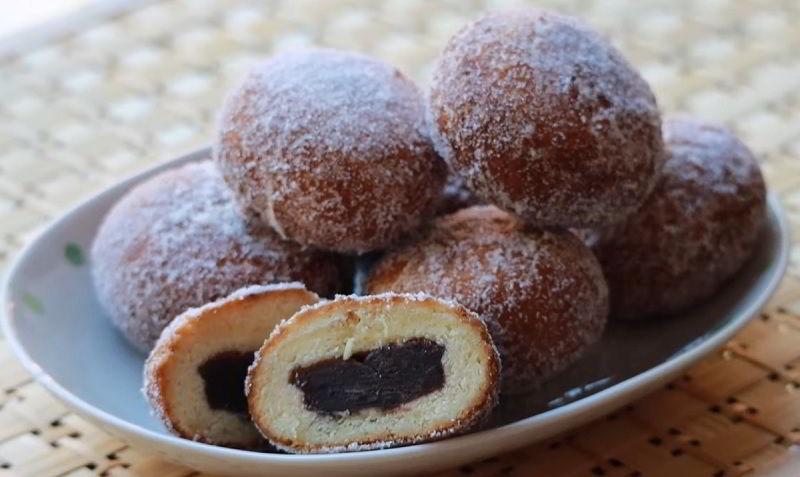
An-doughnut, also known as "an-dough" or "anko-donatsu," is a popular Japanese dessert that is loved for its sweet and indulgent flavors. It is a delightful combination of a traditional donut and a classic Japanese sweet called "an," which refers to a sweet red bean paste. The an-doughnut typically has a light and fluffy texture, similar to a regular donut, but with a unique twist. The outer layer is often coated with sugar or a glaze, giving it a slight crunch. Inside, you will find a generous filling of smooth and rich an paste made from red azuki beans. The an paste is subtly sweet with a hint of earthiness, creating a perfect balance of flavors. Sometimes, an-doughnuts are also filled with other flavors apart from the traditional red bean paste. Popular variations include matcha (green tea) flavored an, which adds a vibrant and slightly bitter taste, or even chocolate or fruit fillings for those seeking a more diverse experience.


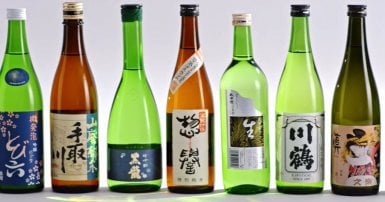
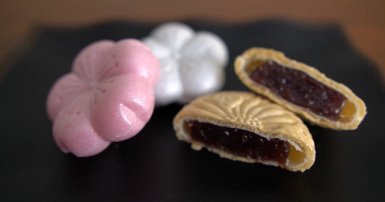
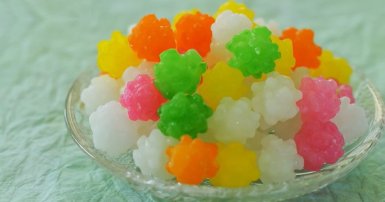
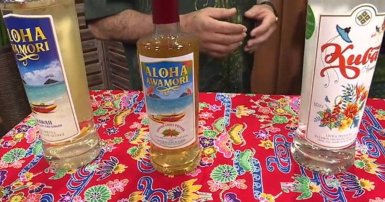
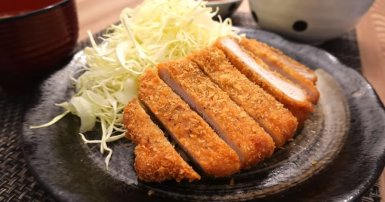
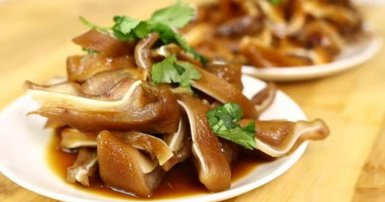
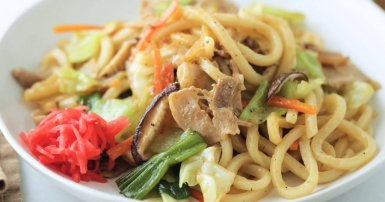
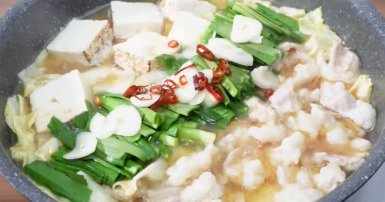

-1709813013.jpg)


